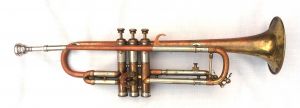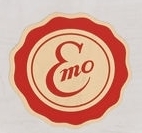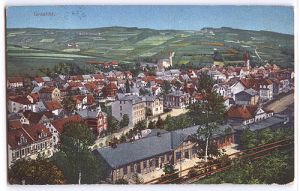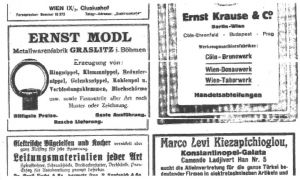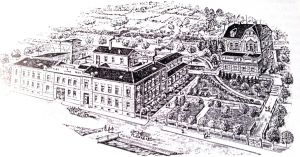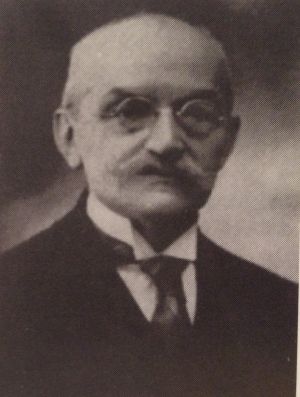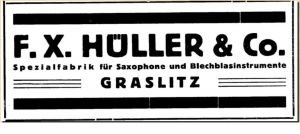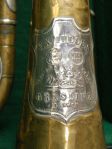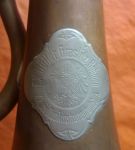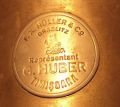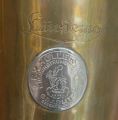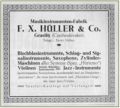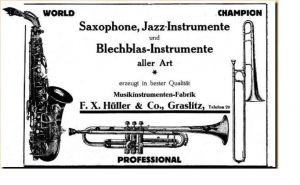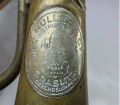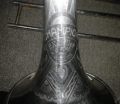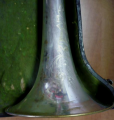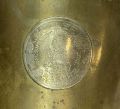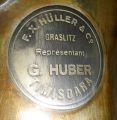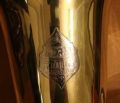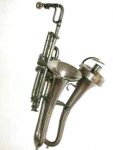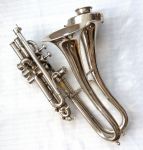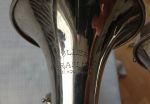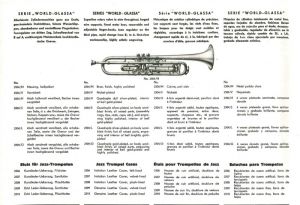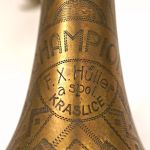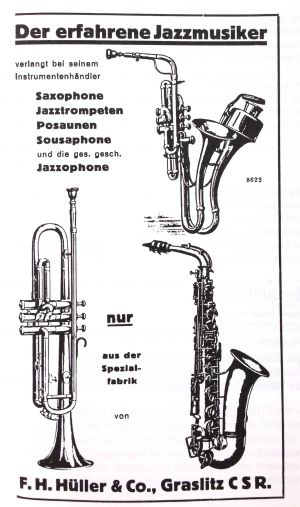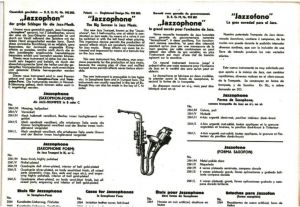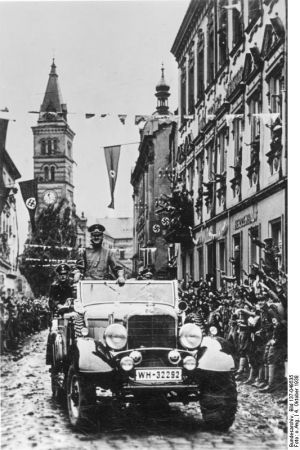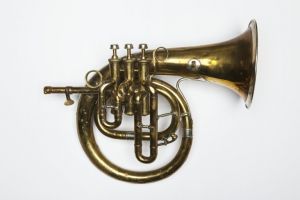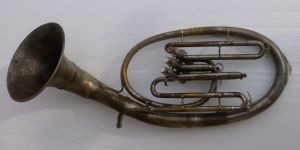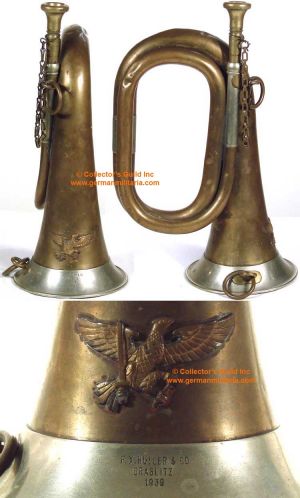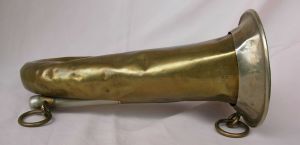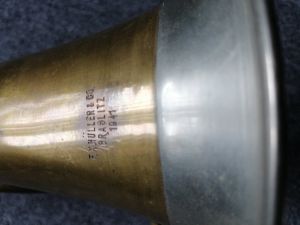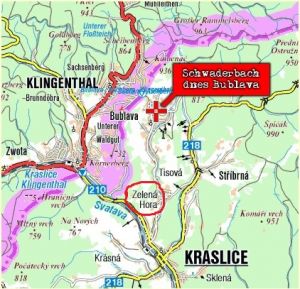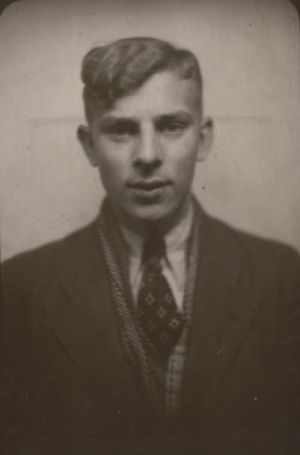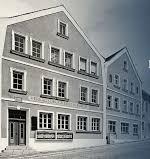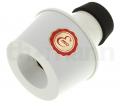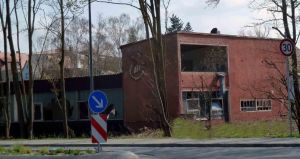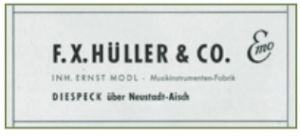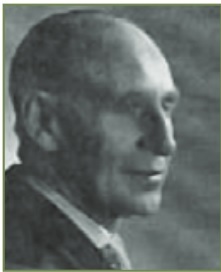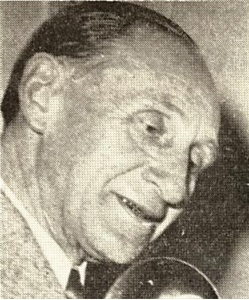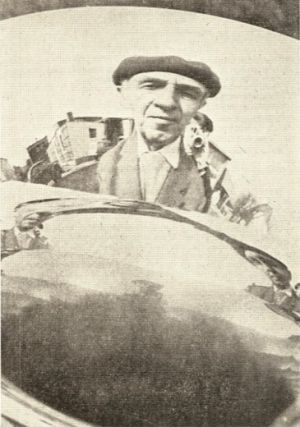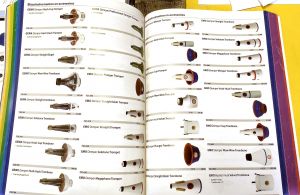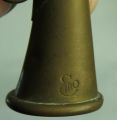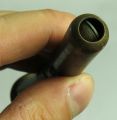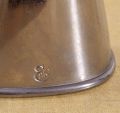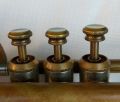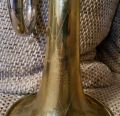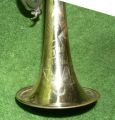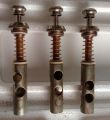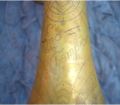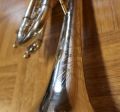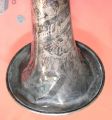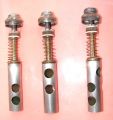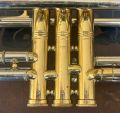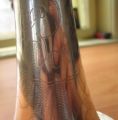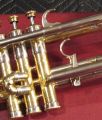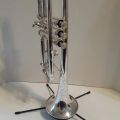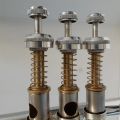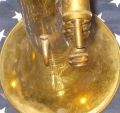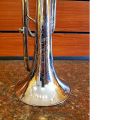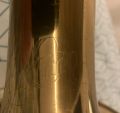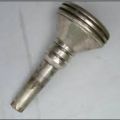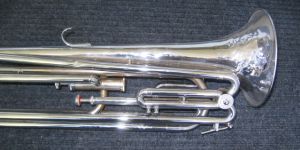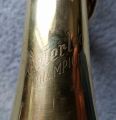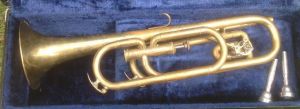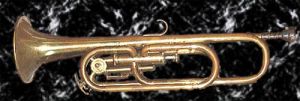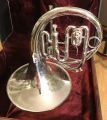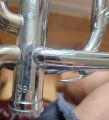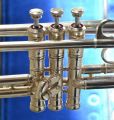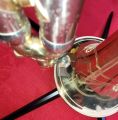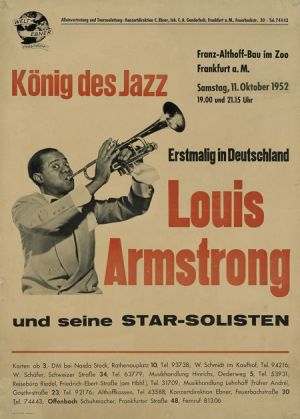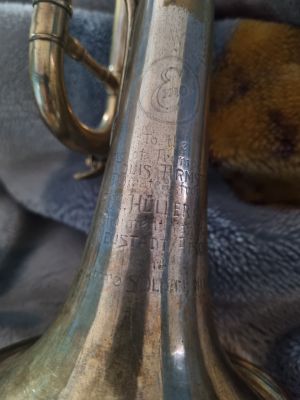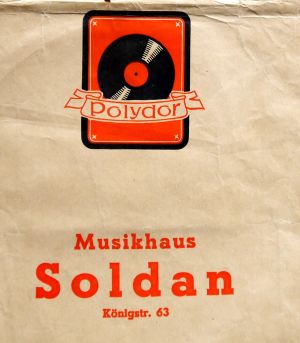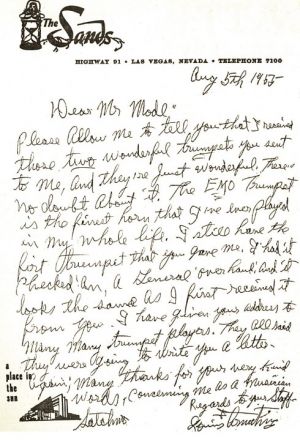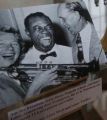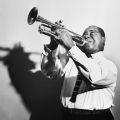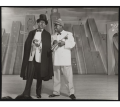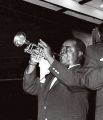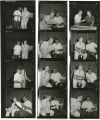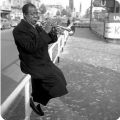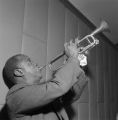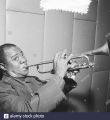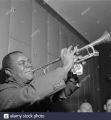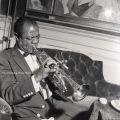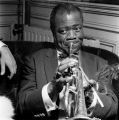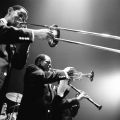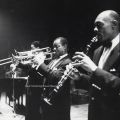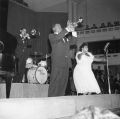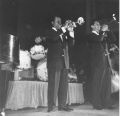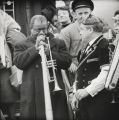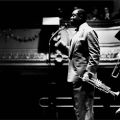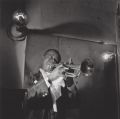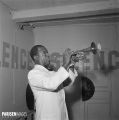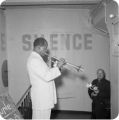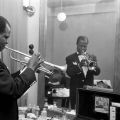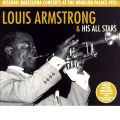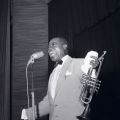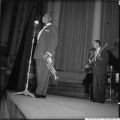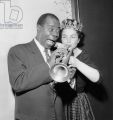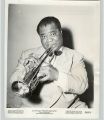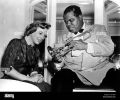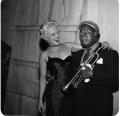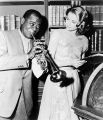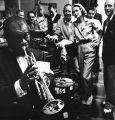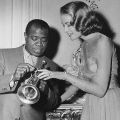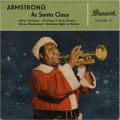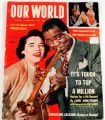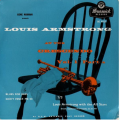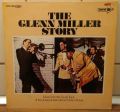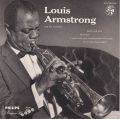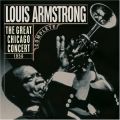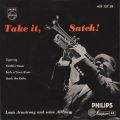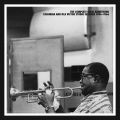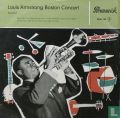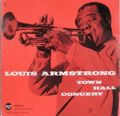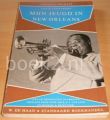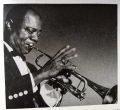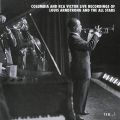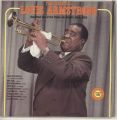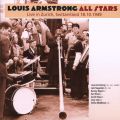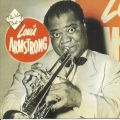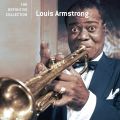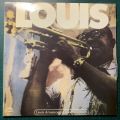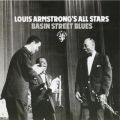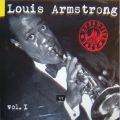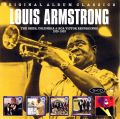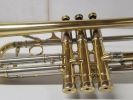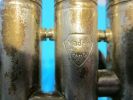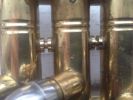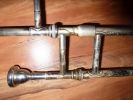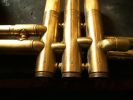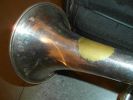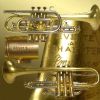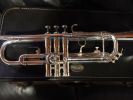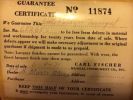Ernst Modl brass instruments
Every now and then an Emo trumpet pops up on Ebay and other auction sites and a potential buyer asks: 'who knows more'. Often the link with Louis Armstrong is mentioned and there are these still available Emo mutes. Little is known about their maker Ernst Modl, who's career started before WWI in Bohemia and ended after WWII in West-Germany.
On this page I collected the available information. Starting with his pre WWII career in the F.X. Hüller company in Graslitz, the war years, his patents, and an overview of his instruments that appear not only under the Emo brand but also under names like Ludwig, Buffet Crampon, Rudy Muck, Smith Music Sales and Waterloo. I made a list of their serial numbers. Trying to connect things and hoping for additional information to come. And I researched the Armstrong connection.
Note: This page focusses on brass and on the career of Ernst Modl. More information about F.X.Hüller and their (pre war)saxophone production you can find at F.X.Hüller.com
Note 2: More about the Second World War history of the F.X.Hüller and Emo companies, as well as of other Graslitz musical instrument makers you can find at Emo Leichtmetallbau, Ernst Modl & Co
Contents
- 1 Before WWII
- 2 WWII
- 3 After WWII
- 4 Ernst Modl brass instruments
- 4.1 Signal horns
- 4.2 Bugles
- 4.3 Emo trumpets
- 4.4 Other Emo brass instruments
- 4.5 Stencils
- 4.6 The story about Louis Armstrong playing an Emo
- 4.7 Hugh Masekela playing the Armstrong F.X. Hüller/Emo
- 4.8 Ernst Modl serial number overview
Before WWII
The life of Ernst Modl starts on July 4th 1892 in Graslitz, Czechoslovakia. Graslitz, now known as Kraslice, is a town close to the border with Germany. It was then part of the Austro-Hungarian empire. Graslitz housed an extensive production of musical instruments, brass and woodwind, but also harmonicas. The other economic pillar was textile industry. At the beginning of the 20th century, there were 86 middle and smaller textile factories and 11 musical instrument factories in Graslitz. There were also 40 independent companies that either produced musical instruments or their components.
The father of Ernst Modl was named Josef Modl, his mother's name was Katherina. There's already a Josef Modl listed in 1771 as musical instrument trader, living at Modlgasse 371 (549) in Graslitz. One of his descendants was Ernst's father, also called Josef Modl, rotary valve block maker and trader of wind and string instruments in the early 1900's at Modlgasse 542/786 in Graslitz, with his workshop founded in 1848. In 1913 Josef Modl is listed along with F.X.Hüller as one of the two Graslitz makers that participate in the newly registered O.Hebron export firm in Berlin, together with a lot of Markneukirchen based traders.
Until WWI the city was booming. In the years of the First World War, the economic boom stagnated. In 1918, Austria-Hungary, to which Graslitz belonged, disintegrated, and the Czechoslovak Republic was founded. After WWI production in Graslitz quickly recovered and at a time there were 59 musical instrument manufacturers in the area including such names as Bohland & Fuchs, F.X.Hüller, A.K. Hüttl and Julius Keilwerth.
Ernst Modl Metallwarenfabrik
From ca. 1918 till 10-05-1920 Ernst Modl is listed as maker of rotary valve blocks (G.Dullat). In the catalog '400 Jahre Musikinstrumentenbau in Graslitz' Dullat also mentions Josef Modl at Modlgasse 542 (786), and he states that it's the same as Ernst Modl at Modlgasse 786, who's listed as 'Maschinen- und Metalblassinstrumentenbau sowie Herstellung von Geschossteilen".
The magazine Elektrotechnik und Machinenbau, Volume 37, Nr 8 has an ad on April 6th 1919 of Ernst Modl Metallwarenfabrik, Graslitz i. Böhmen (Bohemia), producing all kinds of nipples, clamps and sheet metal screens. 'Best prices. Best performance. Fast delivery.' the ads says. It doesn't give a street name/address. So Ernst started a workshop on his own.
F.X Hüller & Co
On 09/06/1919 Ernst Modl marries Philippine Hüller, the daughter of Franz Xaver Hüller. In 1922 a daughter is born. His father-in-law F.X. Hüller was a leading instrument maker in Graslitz. By 1910 Hüller had 200-250 people at work. He built and traded wind instruments and stringed instruments. Hüller, born on December 29th of 1856, in the nearby Pechbach founded his factory in 1882. He then bought the ruïns of the 'Knappschaftsmühle', a burnt mill, and on that spot in 1898 he had a factory and a house built. The factory was known as the 'Schied-Fabrik'. The address was Eibenbergerstrasse 440, now called Wolkerova in the Grunberg part of Graslitz (now: Zelená Horá in Kraslice). House nr 1066 is right behind the factory and is the Hüller villa at the Knappschaftsgasse/Nerudova (cást).
Ernst Modl joined the company in 1919 after he married Philippine. Her sister Susanne had married Anton Riedl (6/6/1884-11/25/1935) in 1911, Riedl joined the Hüller company in 1911. (note: this Anton Riedl is another one than the maker of the Arigra octagonal trumpets).
In 1920, on March 1st, Modl and Riedl together with Philippine and Susanne Hüller became partners in the company (Hüller himself was aged 63 by then). On March 29th 1920 the name of the company changed therefore in F.X.Hüller & Co (F.X.Hüller a Spol in Czech). Modl took on the role of the inventor and craftsman, while Riedl took care of the management and the sales. (Uwe Ladwig). 'He never built an instrument' (Rippert)
In 1921 they were enlisted in the trade register in Markneukirchen, Hüller as manufacturer, Modl and Riedl as Kaufmann (businessman), with the addition that their wives were not allowed to represent the company. In 1929/1930 they are still listed in the Markneukirchen address book. Hüller & Co was one of the first Bohemian factories to establish a branch in Markneukirchen. In 1929 he is listed there at the address Roter Markt 13, and later on in Klingenthal, both only a few kilometres away from Graslitz but then part of the German Empire. The instrument makers in Bohemia exported a lot. Their branches in Saxonian Vogtland helped to get their products all over the world. Especially when they had to deal with the big market crisis and growing tariff barriers as a result of that in the early thirties.
In 1923 F.X. Hüller & Co starts with the production of saxophones, first led by Max Keilwerth. Other departments of the company provide brass instruments and parts, signal horns, drums and cymbals, valve blocks (piston and rotary) and string instruments and parts. There is a saxophone catalog from F.X.Hüller & Co with World saxophones, to be dated around this time (see: F.X.Huller.com). This catalog states in it's english text that Hüller wants to secure his place amongst the leading manufactures of musical instruments. The German text is more explicit: it says that they can take the first place already. Thanks to 'a staff of hardworking and thoroughbred assistants, both technical and mercantile', which seems to be a reference to Riedl and Modl.
In the twenties F.X.Hüller & Co also starts with English model names for his brass and saxophones. In a 1920's catalog World is the name of the most luxurious saxophones. There's also a new 'jazzy' logo that's found on the '1923' catalog and on a 1924 F.X.Hüller & Co letterhead.
The jazzy logo is also found on instruments that went to Romania (Georg Huber, Timisoara, a shop for musical instruments 'representative' for Hüller) and Germany (C.A.Wunderlich, a trader in Siebenbrunn in Vogtland, close to Graslitz on the other side of the border.)
The World logo is also found on this F tuba with top action rotary valves, built after a 1929 patent from Hüller. See also the Top action rotary valve trumpets page.
A very rare bird is this bariton horn with the new World logo but also the brand name Hüriemo. Which is an acronym for HÜller, RIedl and MOdl. A common practice in Graslitz and the nearby Markneukirchen. But so far I found only one instrument with this name. Maybe they choose pretty fast to use only the World model names.
Two F.X.Hüller & Co, Graslitz Czechoslovakia baritone horn with jazzy World logo. The one to the right is also branded Hüriemo, the one to the left has a lowered pitch
F.X. Hüller ad from 1929, mentioning the Hüriemo brand and also the Jazzophone as a novelty.
Several years later in 1932, an additional catalog presents the cheaper Professional and Champion models and next to the World model there is a World de Luxe series (called World Luxus on the German market), for saxophones, trumpets and trombones. (The mutes offered in this catalog are from the Shastock and Jedson brand.)
In the early thirties Hüller & Co trumpets had one or two straight braces in the main tuning slide. Horn-u-copia features an early Hüller & Co World trumpet with a straight brace and a naked lady, a feature that was made famous by C.G.Conn. In 2024 another World was for sale with two straight braces.
And here's a F.X. Hüller World Luxus, beautifully decorated and also with the naked lady.
F.X.Hüller World Luxus, source Auktionshaus Mehlis, 2018
F.X.Hüller & Co catalog pages from around 1932
At one point the naked lady and the jazzy World logo disappear in favour of Art Deco styled engravings of the model names. Below two World trumpets with such art deco engravings.
World trumpet, valves numbered 20, 21, 22 or something like that, source Ebay.de june 2022
A postcard that was sent to relations inviting them to the Leipziger Mess in February-March 1937 mentions the Champion, World and Professsional saxophone models. Hüller advertises trumpets, alto- tenor- and french horns, flugelhorns, trombones, sousaphonen and the Jazzophone.
Business card for the 1937 Leipzig fair, sent to Rauscher musical instruments in Munich
At the end of the thirties the braces of the trumpets change from one or two straight braces to two half circles or two ellipses with a circle in between.
F.X.Hüller a spol, Kraslice, Champion trumpet, left: valve numbers 31,32,33, right: valve numbers 94,95,96
These circle/ellipse braces are found in a F.X. Hüller & Co catalog dated 1939. Here the Professional model seems to have disappeared, and a World Super model is added, between the World and the World de Luxe. According to this catalog the World de Luxe is also available with hexagonal valve blocks, finger rings and waterkeys. A wink to the Arigra like trumpets of the time.
Pages from a F.X.Hüller & Co catalog dated 1939, source: FXHuller.com.
Below a World Luxus, similar to the World de Luxe in the above catalog. Sold years ago by Musikhaus Louis in Saarbrücken with the story that is had been an object on the Leipziger Messe.
World Luxus, valve numbers 22,23,24, source Ebay.de 2024
In the catalog the half circles brace is found on a Champion model. But the trumpet below is a World model and has them also.
A F.X.Hüller & Co World, Graslitz, Sudetengau. That means it's from 1938 or later. source: ebay.de 2020
This one also has engraved 'Graslitz, Sudetengau', Sudetengau being the part of Czechosloavkia that was annexed by Nazi Germany in 1938. It has no Art Deco engraving but a globe logo.
Now the next trumpet is identical to the above Hüller Sudetengau World trumpet and similar Hüller trumpets with two half circles. But it's engraved 'Louis Armstrong' and 'USA', a pretty modest engraving compared to the exuberant Art Deco engravings above. I'm pretty sure it's a Hüller made stencil. It was played by Henk Baas (1924-2003), one of the founders of the Utrecht based NS orkest. According to his son, he started playing it when he was 19 or 20, so that would be around 1944.
trumpet branded Louis Armstrong USA, valve numbers 121,122,123, numbers on the mouthpipe 76 and 49
As Hüller switched to war production from 1939 onwards, I guess it has to be dated around 1939. Maybe Hüller & Co marketed the instrument under this name, or someone else marketed it, as Hüller is known to have made a lot of stencils (especially saxophones). In using Armstrongs name he was not the first, French instrument maker Selmer already came with an Armstrong signature trumpet in 1933. What's interesting is that after the war Ernst Modl offered Louis Armstrong one of his trumpets (by then branded Emo) and that Armstrong played two of them for a few years, instead of the Selmers he used to play since 1933. More about that in the story about Louis Armstrong playing an Emo
Some more F.X.Hüller & Co labelled instruments
F.X.Hüller & Co World bass trumpet, used by vocational school D.Z. Lwow No. 20, (which is Lviv in Ukrain) source Ebay.de 2024
F.X.Hüller a spol, Kraslice Champion trombone
F.X.Hüller a spol, Kraslice, World trombone
F.X.Hüller & Co, Graslitz bombardino with World logo, source: milanuncios.com
F.X.Hüller & Co, Graslitz sousaphon, traded by G.Huber in Romania.
Huller sousaphone model World
F.X.Hüller & Co, Graslitz C.S.R, kaiserbas, 123 cm high and a bell diameter of 61 cm, coll.Uwe Schneider
F. X. Hüller & Co French horn, source Ebay.ca, 2024
Set of F.X. Hüller & Co instruments, traded by G Huber in Timisoara (Romania), sold by Hotel des Ventes des Notaires in Strasbourg, February 2024. I guess an alto horn, tenor horn, Eb tuba and Bb tuba, the smallest measuring 49 cm. The two smallest instruments have a shield with the 'World' logo, the two largest instruments have a shield without.
There are only a few F.X.Hüller & Co labelled (brass) instruments around, the main reason being that it were mainly the traders that put their name on the instruments, not the makers. Or there was no name at all to be found. I haven't started to research those F.X.Hüller & Co brass instrument stencils. Only one example I researched extensively: the Jazzophone, I found some 30 Jazzophones. I believe most of them were made by Hüller & Co, but only one bears their name. Five are branded C.A. Wunderlich, a trader from the nearby Siebenbrunn, one is named Johan Michl & Sohn, another Graslitz instrument maker. The others have no name as far as I know. I don't know if that's representative for the Hüller brass production as a whole, but it might be an indication. On the fxhuller.com site you'll find an impressive overview of the Hüller saxophone stencil production. Again: I don't know if that's representative for the brass production, but it gives an idea. Chasing 'Hüller' saxophone stencils turns out to be possible, for brass instruments it's really difficult, partly because there are so few "Hüller & Co brass instruments around, and also because brass instrument don't have as many 'details' to recognize and compare as saxophones...
Between 1926 and 1932 the company had listed various (D.R.G.M.) patents, like the one for the Jazzophon (1926: DRGM 995305), and one for Top action rotary valve trumpets(1929: DRGM 1087757, 1088742).
The Jazzophone and the Top action rotary valve trumpets were inspired by the jazz craze that came over from the US. As did the exploded production of saxophones.
Ernst Modl might be behind these F.X.Hüller & Co patents as Hüller himself was already in his 70's by then and Modl has a reputation as 'inventor' and listed a lot more patents after WWII (see below).
F.X.Hüller a Spol Kraslice, top action rotary valve trumpet, model Champion
In 1935 Anton Riedl dies at the age of 51. He is skipped as partner. One year later, in 1936 Franz Xaver Hüller passes away aged 80. That means that Ernst Modl was the only acting director of the company as of then. Riedl had been in charge of the management and sales aspects of the business and the firm suffered as a result of his death; 'the company began to lurch' as Uwe Ladwig says. The death of Riedl wasn't the only factor I guess, the musical instrument business around Graslitz (and the nearby Vogtland) was declining as a whole since the world crisis of 1929. Unemployment in Graslitz reached a climax in 1934 at 37.9% of all working people.
In 1936 the company wanted to start a workshop in Klingenthal but this project apparently failed due to the objection of the Czech Ministry of Economic Affairs, as the branch would have caused considerable damage to the industry's carry-over, so Gunther Dullat. Later they did open a branch in Klingenthal. By then F.X.Hüller & Co was one of the biggest companies in town along with Bohland & Fuchs (500 employees), A.K. Hüttl (350), V.Kohlert (300), Stowasser and textile firms like J. L. Ball &Co (500), Durst & Krey (150), Stark & Köstler (700)
In an adress overview of Graslitz that's dated around 1938 'F.K. Hüller' is still listed on Knapschaftsgasse nr 1066, the villa next to the factory. But at a certain point Ernst Modl and his family must have moved in, because at the end of the war they are registered at this address. As a side note, Pavel Palůch notes in an article in 'Sokolovsko' that former German residents of Kraslice remember Ernst Modl as a member of the German Theater Association ("Deutscher Theaterverein ”), where from the founding until the takeover of the association by the former German Labor Front (“ Deutsche Arbeitsfront ”) he was available as a director and very often together with his wife as an actor.
WWII
In 1938 Graslitz (by then more than 35.000 inhabitants) and Sudetenland as a whole became occupied by Nazi-Germany. October 1st saw Wehrmacht forces invading the territory.
On October 4rd Adolf Hitler came along in Graslitz. As a result of the Munich Agreement Graslitz in 1938 was incorporated into the German Reich. From then until 1945, Kraslice was the district of Graslitz in the administrative district of Eger in the Reichsgau Sudetenland.
Military horns
As of 1939 F.X.Hüller & Co and other factories were used to build aircraft parts and war equipment. (Dullat 400). But in those years there were still all kind of instruments made (mainly) for the military. Traditionally Hüller had built instruments for the military. The tenor horn and the alto sax with WL inscription below were built for the music corpses of the airforce (Wehrmacht Luftwaffe), the horn for the music corps of Gebirgsjäger Regiment 139 (Mountaneer regiment).
Alto saxophone F.X.Hüller & Co Graslitz Sudetengau No. 942 WL Copyright 1938
Hüller produced also bugles for the Hitler Jugend and the German Army. They all have a year of production engraved. Below is an F.X Hüller bugle for the Landesdienst (Land Service) of the Hitlerjugend, dated 1939. It has an engraved eagle and swastika underneath. To the side of the bugle is engraved in gothic script “Landesdienst der HJ” with a Hitler Youth diamond below. T
Each Hitler Jugend Bann had a band and each Stamm had a Drum & Fife or Drum & Bugle Corps. The bugles were modeled after the old Army pattern and were tuned to "C". Brass and German nickel/silver construction. The chain is to secure the mouth piece to the bugle. Total height is approximately 28cm. It has a raised HJ pattern eagle, clutching a sword and hammer with swastika superimposed to breast, to horn top.
I found several army bugles, approximately 10" tall.
A seller of one of the army signal horn adds: these were carried by German soldiers throughout the war. Most of the photos of these are from the early war period when the Germans still had enough infantry soldiers that they could launch large scale infantry type offensive operations.
It's interesting that, where Hüller & Co never dated their instruments (and in the case of brass even no serial numbers are known) these instruments are almost all dated 1939.
I found one similar F.X.Hüller & Co bugle dated 1940 and and one dated 1941 and that's it for now. As far as I know no other dates are found on instruments (except from the 'Copyright 1938' date on saxophones, which refers to a Herbert Menge patent, but that's a different story). The other thing is that these instruments are all related to the military. Was there an obligation (from the Nazis) to produce instruments only for the army (and Hitler Jugend...). Had they to be dated because of the scarse copper? Similar dating is found on WWII bugles from other makers, on bugles around WW1 and on UK bugles.
Ernst Modl claimed a patent at the German Reich patent office (of which Czechoslovakia now was part) for a ball joint connection for rotary valves in wind instruments. He claimed it October 4th 1940 it was granted on December 24th 1942 and published in Januar 1943. The full text of this patent, nr DE000000730876A at Ernst Modl's patents.
Soon afterwards production of musical instruments stopped completely. The company is said to have been closed during World War 2. But, like other factories, the premisses were used for war production.
War economy
After the annexation Sudetenland was quickly incorporated in the German war economy. The territory of the Czech Republic was considered fairly safe from bombings during the Nazi regime. Especially in the final stages of World War II, this lead the concentration camps of Auschwitz, Flossenbürg (eastern Bavaria) und Groß-Rosen (Lower Silesia) to establish an extensive system of subcamps for armament production in the Sudetengau, the border areas which had been annexed by the German "Reich" in 1938, and in the Protectorate Bohemia and Moravia. In the Sudetengau, there was neither war equipment nor ammunition production before the outbreak of war. Therefore new businesses had to be created. The most important new forges in the Sudeten area were state-owned companies built according to the "Montan scheme". The Montan scheme was based on trust agreements between the German Reich and the private sector. Private companies (parent companies) received an order from the Army Inspectorate (HWA) for the construction of an armaments company at government expense. A shell contract was concluded between a parent company and the HWA and a subsidiary was founded, which leased the plant from the army's own society for Montanindustrie GmbH (Montan GmbH). In this way, at least 119 companies were created by the end of the war, employing 190,000 people on November 1, 1944. According to this principle, six large arms factories were founded in the Sudetengau in 1939-1940, which were generally treated preferentially in the allocation of labor. Nevertheless, the newly founded ammunition factories in the Sudetengau suffered from labor shortages.
Emo Leichtmetallbau, Ernst Modl & Co. KG
On 29-01-1941 Ernst Modl becomes the only company representative for F.X.Hüller & Co. The 1941 edition of Compass, Kommerzielles Jahrbuch Sudetenland lists F.X. Hüller & Co, Graslitz and as of 1942 Ernst Modl appears in the Jahrbuch with a separate entry. The 1944 version still lists both F.X. Hüller & Co, Graslitz and Ernst Modl & Co Komm.-Ges. (Kommanditgesellschaft, Ltd ) Grunberg. The archive of the Bank der deutschen Luftfahrt AG 1933-1945 lists Emo Leichtmetallbau, Ernst Modl & Co. KG, Grünberg/Sudetenland (until Nov. 1941: F. X. Hüller & Co., Werk II). There's also an audit report ( Prüfungsbericht) from 1939, a Balance sheet, income statement (Bilanz, Gewinn- und Verlustrechnung) from 1940, a location map from Grunberg/Zelena Hora and a company history from 1942. As of 1941 Ernst Modl used Emo Leichtmetallbau, Ernst Modl & Co. KG as a separate company for the war efforts.
The archive of the Deutsche Revisions- und Treuhand AG, 1925-1945 (in the Bundesarchiv) contains the (audits of the) financial statements as of 31 Dec. 1941 and 1942 of Emo Leichtmetallbau, Ernst Modl & Co. KG, Grünberg bei Graslitz. The archive of Bank der deutschen Luftfahrt also contains a contract between the German Reich and the Modl company from 1942/1943 and an additional contract from 1945 (Vertrag zwischen dem Deutschen Reich und der Firma, 1942/43, und Zusatzvertrag, 1945). There is also a document about the employment of 142 Russian workers in 1942 and arrests in 1943. (Bundesarchiv: Verstöße gegen die Betriebsordnung.- Verhaftungen bei der Firma EMO-Leichtmetallbau, Grünberg begin 1943. ) There's an extract of the commercial register from Oktober 21st 1944 and a Dr. Rieffert is mentioned as the sole manager and operator in 1944.
On a separate page the operation of Emo Leichtmetallbau, Ernst Modl & Co in the context of the war economy is further explored, based on these documents.
Forced labor
The work at the Emo factory was done by laborers from different sources, not only Russians. EMO owned a work camp were workers of various nationalities - the Czechs (19%), the Russians (61%), the French (12%), the Belgians (5%), the Dutch (3%) who were totally employed at EMO were interned. During the camp's existence - from February 1942 to April 1945 - there lived 450 people, including 4 women, wives of total workers, and 2 children born in the camp. (Tábory utrpení a smrti, Růžena Bubeníčková et al) , Jules van Egdom, from Belgium was such a forced laborer at EMO from 09.08.1944 tot 10.04.1945. According to Van Egdom the camp for Modl was in Schwaderbach (now Bublava), some 4 kilometers north. He knew that there were made musical instruments at that location before. Previously he worked in Fischamend and Schwadorf near Vienna (WNF Wiener Neustäter Flugzeugwerke), later in Kratzau (Spreewerk) until the liberation by the Russians.
Jules van Egdom, and his Ausweis and Gestellungsbefehl, declaring that he was working at EMO Leichtmetallbau.
Another forced laborer was Dutchman Theo Geijssen from Utrecht (1923-2013). He was in Graslitz before Van Egdom and his description makes me believe that he was at the EMO factory as well. "I was in Czechoslovakia too, it must have been in 1943. A group was selected and they went to Regensburg to work in the Messerschmidt factories, which were a little further away. But when we arrived in Regensburg, those factories were bombed and so we couldn't go to work there. So we split up again and went to Graslitz, a place in the mountains, where there was a village with a machine factory, and then we had to go to work there. We slept again in a Lager. We were there for about half a year, no longer. In Czechoslovakia we had no freedom at all, we didn't see much there either. You had to go all the way up the mountain, there you were sleeping. And then down, you were exhausted in the evening. I stood there all day behind a lathe, I had the day shift, you also had night shifts, which stood behind the same machine as where I was. Then I got comments that those from the night shift made 20 pieces of something and I only 10. So I had to work harder and when I said that I could not work harder, that machine had to be set faster. So I let that machine run faster and then it crashed, haha! It was not on purpose, of course not. If you didn't do what they said they threatened you to go to a concentration camp that was nearby, Theresiënstadt, a very tough camp. Of course you didn't feel like it at all."
After WWII
Kraslice was liberated on May 7, 1945 by the US Army. Only 18 Czechs lived in the town at the beginning of May 1945, but new Czech settlers soon appeared and this number doubled within a few days. The first settlers were Czechs returning from Germany from total deployment and concentration camps, the first Czechs inland came to Kraslice on May 18th. Kraslice became one of the "happier" cities that did not have to experience the most drastic postwar excesses on the part of the Czech population, due to it's geografical location in the American zone. US troops left the city in November 1945.(Archive Kraslice)
Displacement of German population
The twelfth article of the Potsdam Agreement, signed on August 2, 1945, prescribed an "orderly and humane" transfer of the German population from Poland, Czechoslovakia and Hungary. In the case of Kraslice, the Germans were selected on the basis of three categories. The leaders of the German organizations were to be postponed, only those who were in the process or the expectations of the court or questioning could remain. Similarly, former state and public employees were to leave, this time without exception. Only the third category - manual workers and entrepreneurs - was hit harder by the Czech labor force. While traders, farmers and workers were to be displaced "if not needed", miners and specialists had to stay. It was the latter who, among other things, had the task of passing on their knowledge and experience to the new arrivals of the colonists, taking over the "detached" region. The practical side of displacement was the responsibility of the District Administrative Commissions (OSK). These committees acted as individual units, but there was a certain level of intercity cooperation within the regions on the German population. Between the OSK and the US military administration during the first post-war months, there was a noticeable friction, especially because of the aforementioned unwillingness of Americans to agree to an indiscriminate Czech approach to the inhabitants of German origin. Due to the temporary closure of border crossings in the summer of 1945, refugees from the eastern part of the country began to accumulate in border towns, trying to get out of the Soviet zone and into Germany. So the OSK was supposed to secure their accommodation and take care of it until the next border opening, which led to a deeper sense of grievance and disgust on the part of local Czechs. Around forty thousand transferred Germans have accumulated in small Kraslice, and their improvised accommodation had to be arranged in the workers' quarters of Steubing & Co. In addition to the Steubing factory, an EMO accommodation facility was established, which was formerly part of the EMO factory and accommodated 700 people. In both centers the Germans stayed only days or a maximum of one or two weeks before they were sent by train to the west.
The German households received a so-called "Einberufungsschein" (call-up certificate). With the following content (for Graslitz): "You have at least 24 hours after receipt of the notice of appeal with your family in the Collection point ......................... (EMO or STEUBING). Each person is allowed to carry a baggage weighing no more than 50 kg (blanket, pillows, necessary clothing, underwear, shoes and everyday necessities), including food. Upon leaving the collection center, the person summoned must lock the apartment, cover the keyhole with the upper section of the notice of appointment with the head OSK, whereupon the name and address must be written down. All neatly bound apartment keys provided with name and exact address, are handed over at the MSK - housing offices (persons from Kraslice directly in the collection point) together with list of the things left behind in the flat.
Ernst Modl was on the September 5th 1946 train to Nürnberg in West Germany. Aged 54, labelled as 'mechanist' (and not as an instrument maker), with his wife Philippine (51) as household. Train number 14, wagon number 22. Franz Riedl (19) the son of Anton and Susanne, had already left with the train 18-03-1946, with train nr 2, wagon nr. 16. At that time Ernst Modl and his wife and Franz Riedl still lived at the house nr 1066, the villa next to the factory were Franz Xaver Hüller had lived before. The fact that Franz Riedl lived with the Modls could imply that his mother Susanne had deceased by that time. Modl's daughter went to München and stayed there.
In 22 transports between February 28th and October 22nd 1946, 22461 people were displaced from the Kraslice district, from Kraslice alone it was 11,306 people. At the end of 1946, 11531 inhabitants were in Kraslice, of which 7108 were Czechs. During 1947, three more German transports were dispatched. At the end of 1947 the town of Kraslice had 6463 inhabitants, of which 4300 were Czechs and 2042 Germans. The very narrow focus of the Kraslice economy was the reason for allowing more Germans to stay than in other cities and regions. While in the areas of agriculture or heavy industry there was no need to teach new immigrants with the help of German experts, traditional ornamental textiles and the production of musical instruments - with which the Communist regime wanted to continue - were fields whose specialization had to be passed on from the original population to the new ones. Until the 1950s, the German-speaking German population made up forty per cent of the total population (partly due to abstaining experts, partly due to mixed families allowed to remain in Czechoslovakia).
Nationalisation
In 1945 there were 31 larger plants in Kraslice, employing more than one hundred employees, another 88 employing more than ten employees, and many of them still domestic workers. In the vast majority of establishments the producers of musical instruments or their components were working, another significant part consisted of manufacturers of embroidery and lace. All commercial and craft trades and agricultural holdings of German owners were confiscated. Companies with a staff of 21-300 were within the scope of OSK, with more than 300 employees, they were subject to the National Country Committee. Many trades under the national administration gradually disappeared and were disposed of, some merging and creating cooperatives, others gradually merging into national enterprises between 1949 and 1952. As a result of this development, in 1953 there were only four large national enterprises in the field of musical instruments and textile production. They were Amati, Lace, Leko and Ohara. The Amati National Company was formed by the incorporation of 10 inland races to the original Amati cooperative with a founding meeting on 17-10-1945, in the canteen of Hüller, as a source says. It which combined a total of 322 confiscators producing musical instruments on the territory of the Kraslice district. F.X. Hüller & Co was one of them, others were Josef Glassl, Bohland & Fuchs, Julius Keilwerth, A.K. Hüttl, Franz Michl and Kohlerts Söhne. In 1948, the cooperative was nationalized, working back till 1-1-1947. The individual plants were gradually closed down and the production concentrated on Hans Rölz, Köstler and originally the Hupfer textile factories.
The Czech Law Survey provides a notification about the Decree on the Nationalization of EMO-Leichtmetallbau Ernst Modl and Co., KG in Zelená Hora u Kraslic on December 27, 1945. The nationalisation of EMO-Leichtmetallbau came immediately into effect. In an official magazine (Úradný vestník) from 1948 we find a regulation from the Ministry of Industry: "on the nationalization of mines and certain industrial enterprises, incorporate, in agreement with the Minister of Finance, the assets of EMO-Leichtmetallbau Ernst Modl & Co., KG, based in Zelená Hora near Kraslice, within the scope of its nationalization to Perun, laundry and cleaning plant, national enterprise."
In 1952 the legislation on compensation for war damage (Lastenausgleichsgesetz) was adopted. In the archive of the Heimatauskunfststelle Regierungsbezirk Eger, Emo Leichtmetallbau is mentioned in 1953.
The old buildings of F.X.Hüller in Graslitz are today used by a concrete company, Českomoravský. In the early 2000's there were parts of John Deere tractors en machinery made. In 2011 there's a picture of the inside where it was used as a production hall of an engineering company. The buildings of Emo Leichtmetallbau in Zelena Hora/Grunberg were in the post-war history the long-term seat of plant 07 of the company AUTOBRZDY n. P. Jablonec n. N., where the production of air brake cylinders was located (the building was purchased in 1965). Today, the company Kukal & Uhlíř, s. R. O. uses it.
Neustadt an der Aisch
From Nürnberg, where the train brought him, Ernst Modl first went to the Flüchtling Lager, the refugee camp in Fierst, a small village near Ebern, where he stayed from September 8th till September 29th. Then he went 44 km northwest to Neustadt a/d Aisch, where he first was registered at the adress Bambergerstrasse 30. On Oktober 2nd he fills in a registration form. This form was an obligation following the denazification law of the American military government. The denazification was aimed at separating the nazi war criminals from the fellow travellers and the others. Modl states that he had been a paying (RM 2,50 per month) member of the NSDAP from 1939 till 1945. The registration is followed by a procedure at an Arbitration Chamber (Spruchkammer). The public prosecutor wants to list him as a fellow travellor, Modl first complains and claims to have been politically persecuted, because of his arrest and imprisonment by the Gestapo. He presents documents about his release form prison, testimonies of a former archbishop who was with him in prison, of 7 Czech and one Russian workers who state that he behaved well against all the foreigners in his factory, and that nothing wrong could be told about him. He also provides a document that makes clear that he wasn't allowed to have any influence in the company after his release from prison. There's also a document from the Graslitz antifascist comité, stating that he's right about his role in the NSDAP, that he had behaved well against prisoners of war, politically dissenters and other workers in his company. He was no dangerous nazi but he was a beneficiary, who was convicted to 6 months prison because of tax avoiding. After a meeting with the president of the Arbitration Chamber Modl acknowledged that he had not actively resisted the nazi's and he was placed in group 4, the followers, and fined with RM50.
Later on he moved to Nürnberger Strasse 27.
There is a story Mario Rippert told me, that after his expulsion Modl should have become the manager in London for Selmer London. He had good contacts to Premier Drum and Selmer London before the war as he made components for the drum manufacturing. He was there for a week and looked at it, but then went back to Neustadt a/d Aisch, said 'they only have tea-time'. He was just used to work.
On December 3rd 1949, he applies for a Gebrauchsmuster (a kind of 'patent light') for a mute with a sliding cup shaped part (a 'Husch-Husch'mute) for trumpets and trombones. His 'invention' is a rubber ring keeping the two parts tied instead of screws, making the sliding faster and easier. It's granted May 22nd 1950. In the application form he calls himself Musikinstrumentenmacher. At the same time he claims a patent for the impregnation of cardboard made mutes with 'IGECOLL F', a product of BASF, the Badische Anilin- und Soda-Fabrik. Full text at Ernst Modl's patents
Modl started production in Neustadt a/d Aisch under the name F.X.Hüller & Co, Blechblasinstrumente, founded 01-01-1950 (or 05-09-1950?). He didn't make saxophones anymore. He started without money with repairs in an old pigsty, started with the production of mutes, then the production of rotary valves is added. The company’s first new instruments were built in the early 1950’s. Anton Riedl’s son, Franz Riedl (3-3-1927 / 1-9-2008) joined Modl in the resurrected business. Like his father, Riedl’s primary contribution was made in administration and sales, next to his job as musician.
On May 5th 1950 he applies for another mute patent, this time for a wow-wow mute, the invention being that the mute was made of presspan (cardboard) instead of aluminium and the two parts stuck together. The application form has no drawings attached but I guess the idea is a bit like the right mute below, that's still for sale. Full text again at Ernst Modl's patents
Modl applied for another patent regarding rotary valve instruments (on 16-10-1950). This one should make the assembly of rotary spring valves much easier and serial production possible. It was granted 13-9-1951. (pdf to be added).
In 1951 Modl produced signal instruments with already 12 employees at the Nürnbergerstrasse 27. In 1952, a second workshop is purchased, at Zeppelinstrasse 9, the number of employees grew to 30. The production of rotary valves was added and in 1953 all brass instruments were made with 30 specialists (mostly people from Graslitz).
The Staatsarchiv Nurnberg has a document from the Regierung Mittelfranken about a Staatsverbürgter Flüchtlingsproduktivkredit für die Firma F. X. Hüller u. Co., Inh. Ernst Modl, Blechblasinstrumente in Neustadt a.d. Aisch (1950-1961). That implies that he got financial help from the government, a state guaranteed credit, like other fugitives. At another place is mentioned that he got financial help through the Marshall Plan.
Diespeck an der Aisch
In 1954 Modl started the construction of a new company building at Sudetenstrasse 7 in Diespeck near Neustadt a/d Aisch, some 6 km away from the original location. This was registered 10-10-1954. The architect was the husband of his daughter Adrienne Valter. In 1956 followed by an extension/enlargement of the workshop, in the end with 60 employees. In 1962 there came a residential building above the factory. In 1963 Modl lives at Zeppelinstrasse 9, Neustadt a/d Aisch, now the adress of Schmidt Verlagsdruckerei.
In 1955 he was listed as one of the 3456 participants at the Internationale Frankfurter Frühlingsmesse (March 4-8th 1955), where he was in the company of other former Graslitz and now German producers like Julius Keilwerth and Franz Sandner, Hopf & Co, Alois Langhammer, the Gemeinschaft der Graslitzer Musikinstrumentenerzeuger (later Miraphone) and Böhm & Meinl.
In the meantime Modl applied for a few other patents. In 1956 he patented a tuning device for piston trumpets (DE000001726634U). In 1957 a patent for pushing the springs in a rotary valve was patented (DE000001744665U) and a device for making the core of rotary valves (DE000001029215A). In 1959 he patented a new rotary valve design (DE000001111487A) where the valve casings were made of two parts pressed together. In 1960 there was a patent for a rotary valve for brass instruments (DE000001813388U) and another in 1963 (DE000001880190U)and a piston valve for brass instruments (DE000001880191). In 1963 he also patented a ball joint for rotary valves.
Willy Hopf & Co catalog page, late fifties.
In the late fifties Emo World and Emo Champion trumpets and trombones pop up in a catalog of Willy Hopf & Co from Taunusstein, near Frankfurt. On the same page the Selmer Invicta and the Selmer Paris. The Selmer Paris is offered in two bores, 19 called Armstrong, 23 called Harry James.
Lindberg catalog page, late fifties
The Emo World is also offered in the Müsika mail order catalog of Lindberg, München, from the same period. Priced DM 288-327, depending on the version, it's the most expensive trumpet offered in this catalog. Here Louis Armstrong is quoted as an endorser of Emo trumpets, saying "ít's the best instrument I played in my whole life." More about that below.
In the 'ABC der deutschen Wirtschaft' from 1966 F.X. Hüller& Co, Inh. Ernst Modl in Neustadt a/d Aisch is listed as exporting to all countries, producing brass wind instruments, signal instruments, parts, and specilizing in trumpets, trombones, waldhorns, rotary and piston valves.
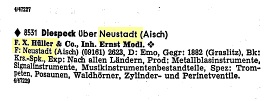 ABC der deutschen Wirtschaft 1966
ABC der deutschen Wirtschaft 1966
In the 'Export Directory of the Blue Book of Europe Ltd of 1972 F.X.Hüller & Co still is listed as delivering trumpets, cornets, trombones, tenor horns and signal horns.
On the Drumcorpsplanet forum member 'Hornsup' describes the factory. He went there as a representant of Smith Music Sales, for whom Modl produced bugles. He visited the factory in 1972 and describes it like this: "The factory was essentially an assembly plant, with most components from other suppliers. The bells were spun in a bell-only factory in Gerhardsried (this must be Geretsried, ed.), right across town from Meinl-Weston (Hornsup also visited Meinl-Weston. It's some three hours drive from Diespeck,ed.). Valve clusters and miscellaneous hardware were also sourced out, although the rotary valves were fabricated onsite. They had a crude drawbench, and could bend up all these components and then hold them together with baling wire while they soldered in a few random braces. The none-too-great chromeplating was done in Nürnburg, but to keep things American the cases were manufactured in good old Elkhorn Wisconsin. I was supposed to go to the factory in 1969 to do some QC (quality control) and product development of a flügel model, but Uncle Sam had other ideas. ... Nobody in the factory had ANY idea of how these instruments were being deployed..... Tony (DeMarco, by then owner of Smith Music Sales, ed.) sent me to the factory for six weeks in the spring of 1972, to do QC and product development. But I realized the first time I walked through that facility that my assignment was hopeless. The facilities, the knowledge, and the craftsmanship just weren't there. I developed a set of prototypes, which were finished and shown at DCA (Drum Corps Associates) that year. But it was too late, Herr Mödl passed away a month later and the factory closed."
After Ernst Modl dies on September 9th 1972, his daughter Adrienne Valter (12.10.1920 † 23.05.2017) closes the factory in 1973 (50-60 craftsman by then).
The workmaster from Modl, Andreas Schmidt would have gladly taken over after his death. But it was too much financially and then he started his own workshop under the name Schmidtco at Schleifmühlstrasse 57, Diespeck and took over several lathes from Emo. Schmidt also maintained the signal horn business for the Belgian military.
The factory buildings then housed a forwarding company for a long time, then it was empty and terrain and buildings became wild. Since 2018 there is a retirement and nursing home, the Martin Luther House of Diakonia, and a building with service apartments on the premises.
From 1973 Franz Riedl and his wife Ingeborg take over the part of the Emo mutes (Dämpfer)under the company name Ingeborg Riedl in their house in the Waldstrasse 8 in Diespeck. Where the mutes previously were made of pressboard, today they are molded from plastic. The Emo mutes were initially molded by the company Heinrich Schneider in Neustadt, after their dissolution by the company HBW, now Gubesch Group, in Emskirchen.
The trombone mutes no. 2 and 4 are still made from pressboard today. The aluminum dampers come since at least the mid-1970s from a metal pressing in Wendelstein. Petra Hieronymus, daughter of Franz and Ingeborg Riedl and her husband George then gradually took over the forwarding of the mutes from her parents and relocated to their house in the Schleifmühlstrasse 45 in Diespeck. To them the mutes are a sideline.
The Emo mutes are sold almost exclusively to the wholesalers GEWA, Stölzel and Thomann, whereby Fa. Stölzel receives all mutes without EMO label and adds their own label to them. GEWA gets the aluminum mutes without an EMO label.
Ernst Modl brass instruments
Ernst Modl started in 1951 with the production of signal horns. The production of rotary valves was added and he picked up the production of bugles, trumpets (piston valves and a few with (top action) rotary valves). Also a few cornets, several slide trombones, a valve trombone and some mellophones are known and then euphoniums are mentioned (but I haven't seen any pictures of them). Throughout his career in Germany Modl used the model names that we know from his time at F.X. Hüller & Co: Professional, Champion and World, with the extensions Super, De Luxe, De Luxe Color and an incidental Standard, Ideal.... As far as I can see now, the signal horns, trombones and rotary valve instruments have no serial numbers. The others have, the Emo branded as well as the stencils he made for companies like Ludwig, Smith Music Sales, Buffet Crampon and Rudy Mück. In the serial number list at the bottom of this page I have listed them. The serial numbers I found so far (some 180, including the stencils) reach from 2 till 8125, with one outlier at 12750.
Signal horns
Signalhorns come in different sizes, used by cyclists, fire brigade, train people, hunting and as a foghorn. Other than trumpets they have a harmonica like reed that makes the sound.
Emo small signal horn, 10,15 cm long and sounds like a harmonica, source Ebay.com 2017
And another one, slightly different, 11 cm long
Emo signal horn, 28,5 cm long and sounds like a harmonica, source Ebay.de 2019
Emo signal horn, 33 cm long, used at SBB?, source Ricardo.ch 2023
Emo signal horn, 45 cm long, used at the Reichsbahn, source Ebay.de 2019
Bugles
There are a few Emo bugles, all with one valve, presumably from Bb to Eb. As they all seem to have hexagonal valve caps, I guess they are from the early years.
Emo signal horn, dating before 1965
Emo bugle converted to a lamp....
Emo bugle, source Horn-u-copia.net
Emo trumpets
The typical Emo trumpet can be recognized by it's spherical waterkeys, the baluster style bracing and the sloping valve caps and "Selmer' style arched valve stem buttons. The World models have these 'Olds' style valve casings and bottoms.
But on a closer look there is more variation, partly because for the early instruments standard parts were used.
Emo Professional
The first few Professional trumpets have the octagonal valve caps and bottoms that are also found on Keilwerth and Wohlrab trumpets. After that they have round caps and bottoms. There's a Professional in Bb and C with a double brace, I guess it's an early one but I dont know the serial number. Then the typical baluster braces also pop up. There are so far two Bb/C Professionals with a spin in the main tuning slide, I don't know their serial number. The waterkey of the Professional is a traditional one, and stays the same over the years. After finding it's form in the early years the Professional model hasn't changed.
Emo Professional, octagonal valve caps, traditional braces, valve numbers 1,2,3
Emo Professional, octagonal valve caps, serial number 4(?), valve numbers 1,2,3, traditional braces
Emo Professional serial number 2, round valve caps
Emo Professional Bb and C, serial number not known, double brace
Emo Professional Bb and C, serial number not known, spin with typical baluster
Emo Professional Bb and C, serial number 46
Emo Professional, serial number 4933, baluster and traditional brace
Emo Professional serial number 8103
Emo Champion
The Emo Champion trumpets all have normal waterkeys, no 'Emo' keys. Between 454 and 747 they get underslung waterkeys, then again normal waterkeys. Somewhere between 2506 and 2676 the valve buttons change from 'Emo' style to 'normal'. The bracings vary but the brace in the main tuning slide mostly is 'Emo'. Most of them have a forwarded position of the valve block ('balanced').
Emo Champion, serial number 18
Emo Champion, serial number 32, different engraving on bell
Emo Champion, serial number 509, underslung waterkey, braces in different styles, hexagonal valve buttons
Emo Champion, serial number 2676, different engraving on bell, underslung waterkey
Emo Champion, serial number 5681, underslung waterkey
Here is an Emo Champion that has an extra loop - to make the instrument shorter I guess.
Emo Champion, serial number 157, extra loop, source: willhaben.at
Emo Champion Super
The Emo Champion Super all have the typical 'Emo' waterkeys and valve buttons. There's a little variation in the finger hoooks.
Emo Champion Super, serial number 632, different finger hook, 'Emo' waterkeys and valve buttons
Emo Champion Super, serial number 8125, 'Emo' waterkeys and valve buttons
Emo Champion Color
So far I know of one Emo Champion Color, it was offered for sale on Ebay in 2024. It has a colored valve block and tuning slides. It has serial number 100, so a pretty low one.
Emo Champion Color, serial number 100, valve numbers 1,2,3
What's remarkable is that there's an Emo Professional with the same serial number, with a different valve block, which suggests that these are from different suppliers.
Valve blocks of two Emo trumpets with the same serial number, left the Emo Professional, right the Emo Champion Color.
Emo World
The Emo World trumpets have a pretty constant shape, with all the known Emo features, including the 'Olds' style valve casings. Most of them have a forwarded position of the valve block ('balanced').
Emo World, serial number 563, balanced
Emo World, serial number 1933
Emo World, serial number 7688
Emo World, serial number 12750, Bauerfeind valve block. The only Emo with a 5-digit serial number.
Emo World de Luxe
Emo World de Luxe have all the typical Emo features. From a certain point they also have a patented third valve slide hook. This patent from Modl dates from July 18th 1956.
Emo World de Luxe, serial number 1433
Emo World de Luxe, serial number 3865, and the third valve slide hook
Emo World De Luxe Color
There's also a multicolored World de Luxe, the World de Luxe Color. So far only in low serial numbers (81-576), like the Emo Champion Color.
Emo World de Luxe color, serial number 81
Emo Standard
An Emo Standard with serial number 492, with F.X.Hüller & Co engraved on the bell was sold in an auction in Stockholm in 2019. This Emo Standard is very much identical to the Emo Professional model. A similar one, with serial number 155, was obtained around 1970 by Magnus Anderson who was living in Stockholm as well. And a third Emo Standard with number 319 was sold in December 2020 from Karlshamm through a Swedish auction site. And a fourth one (no serial known) was also listed by a Stockholm based seller. All four have F.X.Hüller & Co on their bell. That would make you guess that Modl used this model name for the Swedish market. After the war Modl used the F.X. Hüller name for his company until the end but he didn't use it on his trumpets, except for these ones. It's also found on the trumpet Louis Armstrong got with serial number 2503 but that one got a special inscription with Armstrongs name on it as well.
Emo Standard, F.X.Hüller & Co, serial number 492
Elite
This trumpet branded Elite has F.X. Hüller & Co on the bell, in a similar engraving style as the Standard ones above. It has a much higher serial number, 3778. The details like pink and third slide hook fit in the Emo pattern.
F.X.Hüller & Co Elite trumpet, serial number 3778
Emo Harmony
And then there is (so far only) one example of an Emo Harmony, sold in 2021 from Massachusetts, US. The serial number 4596 dates it around 1960. In its details it is identical to the Emo Champion.
Emo Harmony serial number 4596
Emo
Another rare bird is this Emo trumpet without a model name, offered for sale on Kleinanzeigen.de in 2023. It has SP- SV Property inscribed on the bell as well as 4 May 1956. The seller states that it has been US Army property for a long time. After the war the US Army had a lot of bands and piper and bugle corpses in Germany, I haven's been able to find out yet what SP SV stands for but it's very well possible that Modl provided them instruments.
Emo trumpet, 4 May 1956 SP SV Property, source Kleinzanzeigen.de 2023
Other Emo brass instruments
Trombones
There are Emo tenor trombones Champion model and there are also World models around. The slide trombones seem to have no serial number, apart from one with an 18 on the mouthpiece reciever.
Emo Champion trombone, no serial number.
Emo Champion valve trombone, serial number 172
Emo World trombone, source Lot-tissimo.com 2017
One Emo De Luxe tenor trombone was offered on a Swiss auction site in 2023.
Emo De Luxe trombone, source Ricardo.ch 2023
And here's an Emo Champion alto trombone in Eb
Emo Champion alto trombonem, source: Yorkmaster.org
Cornet
There are some Emo cornets around but not many. Here's a World:
Emo World cornet
Emo cornet
And here's a Champion cornet:
Emo Champion cornet, serial number 5645, coll.: Gerard Westerhof
Flugelhorn
A rotary valve flugelhorn, no model name known.
Emo flugelhorn in Bb, source Yorkmaster
There is one piston valve flugelhorn model Champion known. A low serial number so maybe Modl stopped pretty soon producing them.
Emo Champion flugelhorn, serial number 179
Emo Champion flugelhorn, serial number 268, mouthpipe renewed
And another one, no model name known but also with baluster type braces.
Emo flugelhorn, source Horn-u-copia.net
Bass trumpet
An Emo Champion bass trumpet popped up in a music store in Carmichael, California and was sold to Chicago. According to the seller it is a .480 bore, small shank trombone receiver, and the rotor drops it like a F attachment/4th piston would. The ring finger trigger operates a main tuning slide. Water keys have been replaced. It has a low serial number, 59 so probably it's another type of instrument that Modl tried and then gave up.
Emo Champion bass trumpet, serial number 59, source reverb.com
Mellophone
Modl also made mellophones in Eb with rotary valves. The two below have slight diferrences.
Rotary valve trumpet
Although there are several rotary-valve-related inventions under Ernst Modls patents, I only found two examples of an Emo rotary valve trumpet so far. Both seem to have his ball-and-socket invention on board.
Emo rotary valve trumpet, no serial number, source: Catawiki
Emo rotary valve trumpet, no serial number, with plastic valve caps, source Ebay.de
Top action rotary valve trumpet
Modl also made a few top action rotary valve trumpets in various pitches, Eb, Bb and C.
More about these at the Top action rotary valve trumpets page of Brasspedia.
Mouthpieces
Modl also sold mouthpieces with his imprint. They have a caracteristic form, that's also found with the Hablowetz mouthpieces of mouthpiece maker Bruno Tilz, also from Neustadt a/d Aisch. Tilz started his workshop in 1971, after he worked for twenty years for Josef Hablowetz. So I guess it's not a wild guess to think that Hablowetz/Tilz was making the Emo ones as well.
There's also this different mouthpiece, also an Emo 2, with a gold-plated rim and another similar one. Also found under the Bruno Tliz/Hablowetz name.
Stencils
Like F.X.Hüller & Co, Bohland & Fuchs and other musical instrument makers in Graslitz, Czechslovakia and like Julius Keilwerth, Wohlrab and other brass instrument makers in post WWII West-Germany Ernst Modl was active in the production of stencils, instruments bearing another name than his own Emo brand. There is a lot of fuss about the relation between Ernst Modl and brands like Buffet-Crampon, Rudy Mück, Monke, DEG and others. As far as I know Modl made bugles and trumpets for others. But those others sourced their instruments from other suppliers as well, maybe not at the same time. That and the fact that Modl and other makers used parts from different suppliers makes it very difficult to draw lines. What adds to the confusion is that Modl copied a lot of 'Selmer' into his trumpet design. Comparing design and details is one way to connect instruments to a maker. The other line is by looking at the serial numbers. The serial numbers of Emo instruments form a consistent line from 2 till 8000. The presumed stencils have serials that fit in that range nicely. These brands also have serials in totally different ranges, as well as serials that would fit but are from instruments of a different (pre-war) period. So far I collected some 160 serial numbers from Emo and 'related' stencil instruments. I don't have pictures of all of them. And the ones I have pictures of, not always are identical to an Emo instrument. My hypothesis for now is that when it looks like an Emo and it fits in the serial number list, it is made by Modl.
Stencil bugles
Bugles were not new to Modl, after all these were among the last instruments produced before the wartime closure. The first bugles he made were made as stencils for the Ludwig Drum Co in Chicago, USA. These bugles were used in the American Drum and Bugle corpses. These had strict rules as to which tuning and valves are legit. Bugles are traditionally tuned in G, presumably because that pitch was the loudest to use in the military. The first valved bugles added a D, for which William Ludwig is credited. In 1953 a second (piston operated) rotary valve was legitimated. In 1968, Drum Corpses went from approving the G-D bugle to approving the G-F bugle. Here's a link to the history of Drum & Bugle Corps. And here's a link to the evolution of the bugle in the US.
Ludwig
Here's a Ludwig double valve bariton bugle. The owner said about this horn on Drumcorpsplanetforum: "This horn was marketed by Ludwig about 1961, and was manufactured by F.X. Hüller in Neustadt-on-Aisch, West Germany. Besides this baritone, there were bass-baritone, french horn, and soprano models. Some received a 'Peate' stencil and were sold in the Quebec area. Hüller later became infamous for producing the Smith Music Sales bugles. The piston-operated rotary valve was novel, but flawed in its design and prone to jam. Note the stop rod assembly on the rotor slide. In theory, it could be configured either in F# or F. But this is physically impossible, so the half-step tuning was too flat and the whole-step tuning was too sharp. The location of the rotary in these models, immediately after a short leadpipe, was an acoustical abberation. This series of horns was probably the worst instruments that the bugle activity has seen. Although there have been a few other serious challengers for that honor." It looks like Ernst Modl has tried to improve the bugle as well....
Ludwig double valve baritone bugle, serial number 1xx, patent pending, Germany
This is a Ludwig baritone bugle in G. The seller, btrains25 on Ebay: "This instrument was built in the 1960s for Ludwig by Emo. It has two pistons, both thumb actuated, one of which is connected to a rotor on the leadpipe. The real piston drops the horn to the key of D, while the piston actuated rotor is attached to a slide with an extra long tuning slide and stopper which approximates either the key of F (pulled out), or F# (pushed in). This was one of the first designs of bugles which integrated the newly (1953) legalized rotary valve. Rotors in the leadpipe were phased out for rotors in the tuning slide. This particular voice was known in catalogs at the time as a 'Baro-tone'.
Ludwig single valve baritone in G, made in Germany
Here's a Ludwig single valve bugle in G made in Germany. It has serial number 652 and was used by the USMC, United States Marine Corps. In the serial number list below I only incorporated the Ludwig bugles that have a serial number that fits into the Modl list. Which doesn't proe they were all made by Modl. There are a lot of Ludwig bugles with 5-digit serials that for sure are not Modl made.
Waterloo Music Company
Waterloo Champion G-D soprano bugle, serial number 666, bought in Canada, coll.: Brian Hamel
Here's a G-D soprano Bugle with a rotor that lowers the pitch by a half step built by Modl and stencilled Waterloo Music Company. The Waterloo Music Company was a Canadian music publishing and musical instrument retailing firm that was founded in 1921 by Charles F. Thiele (1884-1954) in Waterloo, Ontario. On the Trumpetherald forum James Becker comments on this one: "It appears there to me there are two slides, one on the piston loop and the rotor assembly is a removable tuning slide. The combination of G, F#, D was transitional. The addition of a single piston to the G bugle came first and was a D. However with the introduction of the 1/2 step F# rotor the piston loop was reduced to a whole step F. This combination allows for the greatest number of scales leaving out the 1-3 or 2-3 trumpet fingering equivalents. Written Ab above the staff can be played with the piston sounding flat which is why later two piston designs have a spring loaded 1st slide to raise this note."
The valve caps and button are Emo, the valve is similar to the one in the Emo tarv trumpet, and based on a Modl patent.
Left: another Waterloo Champion, sold from Calgary, Canada.
To the right is another G-D soprano bugle built ca. 1961 by Modl. The rotary valve is a too-long half step that can be pulled to a too-short whole step.
Smith Music Sales
Smith Music Sales in Chicago was set up by Glen C. Smith. At the Drumcorpsplanet-forum members 'Scooter Pirtle' and 'HornsUp' (who worked at Modl in West Germany for a while, developing G bugle prototypes) described the history of the Smith company and the relation with Modl which I quote in it's entirety: "Glenn C. Smith initially worked with the Austin Grenadiers of Chicago during the 50s and gained notoriety as their DM. Then for a while he somehow became the bandmaster at a Catholic boys HS. He started a business to contract bugle fabrication through other firms (initially through T.J. Getzen) that resulted in the 'Smith Music Sales' badging that can be encountered on a wide array of valve/rotor bugles. He was in the bugle sales business at least by 1959 when he brought his mobile shop to the AL Nationals. He took this operation to Miami for '61 VFW with two employees: Bob Spevacek former director and music man for the Madison Scouts, and national champion snaredrummer Tony DeMarco. Smith had a storefront on W. Fullerton Avenue for several years, then moved to one in Mount Prospect.
Smith Music Sales double valved baritone bugle, serial number 227
This double valved baritone bugle belonged to a Boy Scout troop leader back in the 1960's
Smith Music Sales single valve bugle, serial number 510
Smith Music Sales eventually became a large dealer that boasted of international accounts and sales to 3,000 drum and bugle corps. A letter from Smith indicates his company eventually purchased the Holton/Ludwig bugle line and Bill Ludwig declared Smith Music Sales as the 'largest parade drum dealer in Ludwig history'. He was the major source of Getzen bugles, while Tru Crawford set up shop across town and pushed the Holton-built Ludwig Classic line. At the same time (during the 50s), Smith began putting his shield on bugles manufactured in Neustadt-on-Aisch, West Germany (and possibly other Euro-based fabricators). The factory was owned by Ernst Modl, who had one of the many brass instrument factories in prewar Germany (not correct: Graslitz was in Czechslovakia, ed.). It had been re-established after WWII through the Marshall Plan.
Modl had previously built stencil bugles for Ludwig - the notorious "double-piston" models, around 1961. They had a crude drawbench, and could bend up all the components and then hold them together with baling wire while they soldered in a few random braces. The none-too-great chromeplating was done in Nürnburg, but to keep things American the cases were manufactured in good old Elkhorn Wisconsin. Smith also sold some front-carried euphoniums as early as 1964, that they were made Emo. I ("Hornsup') was supposed to go to the factory in 1969 to do some quality control and product development of a flugel model, but Uncle Sam had other ideas. While all this was going on, Holton and Ludwig both decided to get out of the bugle business. With a personal loan from Bill Ludwig Jr., Smith bought the remaining inventory of about 1000 Classic Sopranos.
Below is a picture of the baritone and french horn buglers from the Racine (Wisconsin) YMCA Kilties Drum and Bugle Corps in 1967. They were the first to use the new G - F bugles from Smith Music Sales. This picture was used in Smiths advertisements during the fall of 1967 and much of 1968. It has to be confirmed that these were Emo made.
Racine Kilties Drum and Bugle Corps 1967, source: George Fennel, We winna be dauntit.
The legalization of the G-F bugle (in 1968 ed.) had lured Olds into the business. With a superior product, they soon dominated the market. So Glenn Smith sold his business, a pig in a poke, to former employee Tony DeMarco. Tony sent me ('Hornsup') to the Emo factory for six weeks in the spring of 1972, to do quality control and product development. But I realized the first time I walked through that facility that my assignment was hopeless. The facilities, the knowledge, and the craftsmanship just weren't there. Nobody in the factory had ANY idea of how these instruments were being deployed. I developed a set of prototypes, which were finished and shown at Drum Corps Associates championship that year. But it was too late, Herr Modl passed away a month later and the factory closed. Tony DeMarco had other successful business interests and didn't continue as Smithco. Glenn Smith did enter the Catholic priesthood."
Tubenet-forum member 'aqualung' recalls that in the mid-sixties Smith Music Sales came with a contrabass bugle, made by Emo. "They were made with 4/4 BBb tuba bodies, but still at baritone bore." The contrabass bugle was legalized for the 1962 season.
According to 'Scooter Pirtle', Smith has suggested that he was responsible for the creation of the French horn bugle, a small bore soprano he called the 'Angel horn', the flugelhorn, the bass baritone, a double sized contrabass, and the mellophone. He contended he did this design work with the help of Bob Spevacek, John Gates, Bill Scarlett, and even Arnold Jacobs.
Smith Music Sales Company 2 valve French horn G bugle, serial unknowm, Emo bracing
Here's another Smith Music Sales bugle with one piston and one rotary valve in the form of a French horn. It has serial number 754 and all the Emo details like braces, valve cap and button, and the rotary valve. It was owned by the Loveland Cavaliers from Loveland Ohio.
Smith Music Sales Company 1 valve French horn bugle, serial 754, source: Reverb.com 2021
Here's another French horn/Mellophone with rotary and piston valve, serial number 390. Although it's not branded Smith Music Sales but has 'NMS' engraved, it's obviously the same make.
NMS french horn/mellophone, serial nr. 390, sold from Milton Delaware, source FB 2024
Stencil trumpets
There are trumpets of different brands that are attributed to Modl. Certain Buffet-Crampon, Evette & Schaeffer instruments and Rudy Mück (the 4M and 7M series) are looking very similar to the EMO World. DEG Ranger II, Wilhelm Monke and even a Schenkelaars are also linked to Modl, it's also suggested that Monke was the one who made the Buffets and Mücks. I don't think he did.
My global hypothesis is that Buffet-Crampon and Rudy Muck trumpets from the 4M and 7M series (and also the 2M and 5M series) were produced/assembled by Modl, at least those with with three to four digit serial numbers. The five and six digit Buffet's, Evette & Schaeffers and Rudy Mücks, looking very similar to the four digit ones, were possible made by another (German) maker, maybe Böhm & Meinl. In addition to the exterior similarities, I find support for this hypothesis in the overview of serial numbers below. It turns out that (so far) all these presumed Modl stencils (except the above mentioned 5/6 digit instruments) fit nicely in one serial number list, as do the bugles. I hope that new entries can falsify or support this hypothesis, so if you have an instrument of one of the brands below, please provide me with a serial number and pictures at info@brasspedia.com!
Buffet-Crampon/Evette & Schaeffer
Buffet-Crampon was a maker of woodwind instruments, most famous for their clarinets. The French instrument maker Denis Buffet Auger set up his workshop in the heart of Paris, at 20 Passage du Grand Cerf in 1825. In 1836 Jean-Louis Buffet, Denis' son, married Zoe Crampon in 1836 and created the famous Buffet-Crampon brand name. In 1885 the company is headed by Paul Evette and Ernest Schaeffer. Buffet-Crampon and Evette & Schaeffer were both used as brands. In 1908 Buffet began exporting instruments to the US. In 1918 Buffet began marketing their premium line instruments under their own name, while marketing lower grade instruments variously under the Evette & Schaeffer and Evette brands. During the 1930s Buffet began outsourcing Evette & Schaeffer instruments to other manufacturers.
Buffet-Crampon made some brass instruments around 1895, discontinued it later and are believed not to have made brass instruments again until the acquisition of Courtois and Besson in 2006. The Buffet brass instruments were made for the American market where Carl Fischer in 1910 had acquired the importation rights for Buffet-Crampon woodwinds. Carl Fischer was Buffet agent till the late sixties. In 1940 the Carl Fischer company acquired the York Band Instrument Company for $300,000. In 1957 they still owned it. In 1950-1951 Carl Fischer also purchased a controlling share in Rudy Mück.
There is a hear say statement of Zig Kanstul, saying that Buffet-Crampon made trumpets themselves, but I haven't found any eyewitnesses. The Emo-like Buffet-Crampon trumpets have serial numbers ranging from 29 till 5000 and in the 600.000 -700.000 range. The Evette & Schaeffer trumpets also have 4 digit numbers and (mostly) serial numbers in this last range. Some of them have Germany or W-Germany on the reciever. The four digit numbers nicely fit in the Modl serial list. My hypothesis for now is that these are Emo build trumpets and that the 6 digit numbers came from another German producer, maybe Böhm & Meinl (looking at the valve block). What's interesting is that one of the Evette & Schaeffer 6 digit trumpets was sold on 6-9-1971. Which means that it was made within the time frame of Modl's activities.
Anecdotal 'evidence' for the Buffet's being Emo's is provided by Trumpetherald member seouljourner: "I have one (Emo) with no serial number and 'normal' water keys. It has a medium bore (0.450") and a 4 3/4" bell. It is a balanced trumpet like the Selmers. I have never tried a Selmer so I cannot compare. I do however, have a Buffet Crampon balanced model and the 2 play very similarly, in fact the slides are interchangeable so I believe they are made by the same manufacturer."
Comparing an Emo World with a Buffet-Crampon.
Buffet Crampon in 1981 becomes part of the Boosey & Hawkes group. They buy the Courtois and Besson brands in 2006 and in 2012 become the Buffet group.
The Buffet-Crampon trumpets.
And the Buffet-Crampon trumpets with higher serials numbers from another maker.
Rudy Mück
Some Rudy Mück trumpets are quoted as '(maybe) made by EMO/Ernst Modl'. This is particulary true for the 4M and 7M models that look very similar to the Emo World. Rudy Mück jr. (1909-1959) was a trumpetmaker and also famous for his cushion rim mouthpieces, introduced in 1933. There's an extensive Rudy Mück history on the Brasshistory site of Jon Patton, most of it gathered together by Fred Cirksena. The Muck family owned a large music store. Rudy Muck Sr. and Jr. were both trumpet players. They began producing trumpets and cornets some time before WWII. In 1950-1951 Carl Fischer purchased a controlling share in Rudy Mück. On the Trumpet Herald forum Heavyweight member stated in 2018: "Some of the Rudy Mück horns were made by Böhm & Meinl in West Germany. I think that was after Carl Fischer Music of New York City purchased the rights to the name." According to Bill Barnes on the same forum, the name was owned later by Mike Fiore in NYC who had his own repair shop. Mike had worked for Rudy Mück for a long time and he owned the Rudy Mück name after the last of the involved Mücks passed on. Fiore retired in the seventies. Barnes: "The name was pirated by a European company who made low priced "Rudy Muck" trumpets, perhaps some time in the 1960's. I think that included the balanced models. I have seen all sorts of weird Rudy Muck trumpets, some good and some not so good, so I think the name was used by several different foreign manufacturers."
The Rudy Muck 4M and 7M models look very similar to the Emo World. I'll try to make a case also for the 2M serie that in my opinion is pretty similar to the Emo Professional and Emo Champion model. The 5M is a bit different. The earliest Emo lookalike however is a Rudy Mück Academy Super (serial number 810) followed by a Rudy Muck Citation (serial number 1050). And there is one difference between Rudy Mück and Emo, all (?) the Mück's have a main tuning slide stop rod, no Emo has that. That is, there is one Emo so far that has one.
The Rudy Mück M series 4 digit serial numbers fit in the Ernst Modl serial number list. And, what's important to notice, so far I didn't find any duplications with Emo trumpet numbers. Which might be an indication - at least - that they indeed come from the same source. On the other hand, after WWII there were a lot of instrument makers expelled from the Czech city of Graslitz that restarted in Germany with new serial numbers.. The M models were (all) marketed by Dallas London, the European company Barnes accuses of 'pirating', and they have often 'Foreign' engraved which implies that they were sold in the UK but were indeed sourced from abroad. There are other lines of Rudy Mück trumpets that have four digit numbers; at least part of them date from before WWII. And there are 2M, 4M, 5M and 7M model instruments that have much higher numbers, in the 600.000 region.... These might be the Böhm and Meinl ones?
The Rudy Mück 4M and 7M have valve caps and waterkeys like the Emo World.
The difference between the 4M and the 7M are the brace in the main tuning slide and the third valve slide operating mechanism that the 4M has not. This mechanism is also found on the Emo World de Luxe.
As to the similarities between the Rudy Mück 2M and the Emo Professional, here's some evidence.
These two trumpets above are identical, apart from, again, the stop rod and the pinky ring.
The Rudy Mück 2M is the very basic model, the 5M has a brace in the main tuning slide that doesn't look like Emo.
The higher (600.000 up) numbers look a lot like the 4 digit instruments but they must come form another source. Probably Bohm & Meinl, as the valve rings on the 4m model are identical to those on Bohm & Meinl trumpets. The 7m look a lot like the BM Symphonic (with similar serial numbers) that Bohm & Meinl made.
The Rudy Mück 2m and 4m with 4 digit serials have the same valves as the Emo Champion, the 6 digit ones valves are identical to Böhm en Meinl. (to be illustrated)
Böhm & Meinl, B&M Symphonic
There are some B&M Symphonic trumpets that look like the Buffet Crampon/Evette &Schaeffer instruments, that look like Emo World copies. Böhm and Meinl are mentioned as potential makers of those Buffet and Evette trumpets, sold through Carl Fisher, and also as makers of some Rudy Mück trumpets.
The merchants Wilhelm Böhm and Andreas Meinl founded Böhm & Meinl GmbH on November 1, 1946 (on other places November 1, 1948) in Geretsried, Bavaria. They both were, like Ernst Modl, expelled from Graslitz, Sudetenland. Wilhelm came on 4-4-1946 with his wife and two brothers with one of the first trains. He was 41 by then and had NSDAP behind his name. Meinl, listed as a 42 years old bookkeeper, came with his wife and three children by train on 12-06-1946. The company history was described in 2017 in a local newspaper based on a publication of the Arbeitskreis Historisches Geretsried. Wilhelm Böhm was a retail and wholesale merchant for music supplies. His partner Andreas Meinl had worked his way up from apprentice to general manager at the A. K. Hüttl company in Graslitz. He was very familiar with the manufacture and sale of high-quality brass instruments. They found trained brass instrument makers from the Graslitz area as employees, who had also ended up in Geretsried as expellees. The money for this comes from the State Agency for Development Financing. The first company headquarters was in a garage on what is now Graslitzer Strasse (formerly Kolbenheyerstrasse). The pillars of the company were the trade in music and the repair of brass instruments. These were soon made as well. The garage was bursting at the seams, so the two men rented a former bunker on St.-Hubertus-Strasse. Meinl refreshed business relationships with old customers of his company in Graslitz; demand was particularly high in the USA. There was no shortage of workers: many people from Graslitz were happy to be able to work in their old profession. At the beginning of the 1950s, Böhm & Meinl already employed almost two dozen people. The musical instrument factory developed so quickly that the premises on St.-Hubertus-Strasse soon became too small. In 1953 the company moved to a bunker on the Isardamm. The company stayed there for more than five decades. The demand for brass instruments rose sharply in the years that followed, and Böhm & Meinl developed into a powerful company.
The main customers at that time came from the USA. Up to 600 instruments were manufactured and shipped overseas each month. At that time, the export share was over 80 percent of the total production. The number of employees reached its highest level in these years and was almost 100 employees. One of those customers was the Carl Fischer company in New York. Fischer acquired the York factory in 1940. Böhm & Meinl started making tubas for Carl Fischer to market under the York label in the 1950s-60s, the York Master. It is unclear how much production help Fischer gave to them in the development of these instruments. They also made stencil horns based on Fred Marzans 1968 designs in addition to selling under their own name. The company founders ran their company for almost three decades. Wilhelm Böhm died in January 1976, the Böhm community of heirs withdrew from the company and Andreas Meinl passed his share on to his sons Gerhard and Wolfgang Meinl. Both were partners in the company from January 1977.
The US export boom ended when the dollar fell against the D-Mark. Strong competition from Taiwan also contributed to a noticeable decline in US business. But: new customers were found in Europe and Japan, so that the overall production remained at the same level. Folk music in the Oberkrainer style set new standards. 30 Oberkrainer baritones were already sold before they were produced. The demand for sousaphones for military bands from all over the world also increased sharply. In 1983, Böhm & Meinl delivered over 130 sousaphones and other bell-front instruments to Chile alone. The chapter of the musical instrument factory Böhm & Meinl was closed in 1992. As there was no suitable successor, the production was bought by Walter Nirschl of the Geretsried company B&M-Symphonic. Production continued in the Böhm & Meinl company building until the end of 1996. In 1997, Nirschl relocated the company's headquarters to the Buchenweg, and in 2007 it moved to the Geltinger industrial park. Metal wind instruments, mainly tubas, are still manufactured there for worldwide sale.
As to the BM Symphonic, the brand (with the logo showing three trumpets (Schalmeien)), was used long before Nirschl took over, in the sixties already. A BM Symphonic with serial 73219 is dated around 1960. And a BM Symphonic 671688 was dated 'before 1970'. These were not Emo look-alikes. The above Emo look-alikes has serial number 712102, the first Evette look-alikes have numbers in the 68000 range, one of which is dated around 1971.
Carl Fischer, New York
Wrapping up, there are lines from the brands Buffet-Crampon, Evette & Schaeffer and Rudy Mück to the Carl Fischer company. And there are lines from Böhm & Meinl to the Carl Fischer company. The Buffet brass instruments were made for the American market where Carl Fischer in 1910 had acquired the importation rights for Buffet-Crampon woodwinds. In 1940 the Carl Fischer company acquired the York Band Instrument Company for $300,000. In 1957 they still owned it. Carl Fischer was Buffet agent till the late sixties. There's no doubt that Böhm & Meinl made tuba's for Carl Fischer. In 1950-1951 Carl Fischer also purchased a controlling share in Rudy Mück. For now my hypothesis is that the 5 and 6 digit instruments were made for Carl Fischer by Böhm & Meinl (who also had serial numbers for other trumpets up to there), and the four digit ones were produced/assembled by Modl.
Other names that are sometimes connected to Emo
Buffet-Crampon, Evette & Schaeffer and Rudy Mück are the names that are most often connected to Emo and their story is elaborated above. There are some other companies that come along in this context where the connection sometimes is more doubtful. And some could very well be stencils.
Wilhelm Monke
Wilhelm Monke is sometimes suggested as the maker of Modl trumpets. I don't think he was. Wilhelm Monke (1913–1986), son of brass instrument maker Josef Monke, opened his own independent shop in 1945, which sold a variety of instruments until it closed in 1994. He bought ready-made components and used them to build his instruments. He also bought ready instruments and engraved them with his name. It's possible that he bought Modl's instruments, or that he bought the same parts. But I don't think that Monke made Emo instruments. The ones I found so far have different details but look more or less like Modl instruments. The serial number 52 would fit in the Modl list, but the number looks a bit weird. And there's also a Buffet mentioned on Answers.com with the same serial (but without a picture).
Wimo, Wilhelm Monke Köln, no serial number
I also found a Modl like Josef Monke trumpet. So far it's an outlier between the other Josef Monke piston trumpets around.
Here's a bass trumpet by Monke. Waterkeys and braces look like Modl, but for the rest the design is totally different from the Modl bass trumpet.
Wilhelm Monke Basss trumpet, source Ebay.de
Heribert Glassl
A trumpet with only the engraving H. Glassl Rüsselshein Königstadten (a place near Frankfurt) was advertised in 2021 by a seller as being an Emo World. Heribert Glassl is/was a small shop in that place. Heribert himself retired in 2005. It looks very much like an Emo, what's strange is that there is another Emo with the same serial number (180), an Emo Professional.
H.Glassl Rüsselsheim Königstädten, serial number 180
Luxor
Luxor was the brand name of a German group of several music dealers who bought instruments from various manufacturers in the 1970's and 1980's and then sold them under the Luxor brand. Most of the Luxor trumpets that can be found are by Kühnl and Hoyer. This one is identical to an Emo Champion.
Luxor trumpet, serial number 440, identical to Emo Champion
Hug & Co Zürich
Hug & Co in Zürich, Switzerland, is a large musical instrument retailer, originally a sheet music publisher. This trumpet, for sale on Ebay in 2023, looks identical to an Emo World de Luxe.
Hug & Co serial number 3498, bell nr 11156, identical to Emo World de Luxe
Jubilee
This cornet, with serial number 4697, was offered for sale by Brian Robson from Nightingale trumpets in the UK. It has all the Emo details. The last three digits of the serial number are also found on the back of the water keys, a detail that's found on some other Emo trumpets as well. The Jubilee model name is used every now and then. For instance Julius Keilwerth, another German instrument maker, made saxophones and at least one trumpet branded Jubilee in the fifties. Those were sold in Canada.
Jubilee cornet, serial number 4697, coll. John Parker. The last picture shows the serial number on the water keys
DEG
Member CDFHorn on the Horn-U-Copia forum states that Modl made some of the DEG instruments, some Ranger II models and some Caravelle models. The ones he mentions have serial numbers 135 (Caravelle, flugel), 335 (Ranger II, cornet), 701 (Ranger II trumpet) and 2601 (Caravelle, trumpet). Although they have some similarities in details, the serial numbers are far too low to be Modl instruments when you realize that they have to be post 1965. because that's when D.E.G. Music Products Co was started in Lake Geneva, Wisconsin USA, by Donald E. Getzen after he split from the Getzen company in Elkhorn. According to the Getzen company history, Bob Getzen, who had left Getzen in 1959 to start Allied Music, in 1966 started to build piston bugles for the D.E.G. Music Products Company of his brother Donald. As of 1972 Allied Music begins producing a full line of trumpets, cornets, trombones and marching brass instruments for D.E.G. Maybe these DEG instruments originated here, the low serial numbers would fit perfectly.
Schenkelaars
There is a Schenkelaars Champion with similarities to the Emo instruments (waterkeys, baluster, valve caps. And of course the model name). It has a 3 digit serial number (425?). Schenkelaars was a Dutch maker of all kinds of musical instruments, based in Eindhoven. Founded in 1928 by Harry Schenkelaars (11/8/1896- 2/27/1979). They quit in 1988. Champion was not a much used name by Schenkelaars (his labels were Topaz, Prestige, Concorde and later on model numbers) and there's no further evidence.
The story about Louis Armstrong playing an Emo
The Emo trumpet has a reputation that it's also been played by famous trumpeter Louis Armstrong (1901-1971). Louis Armstrong played dozens of instruments during his lifetime. Even though he believed you could play a trumpet for a long time, he had the habit of playing his trumpets for approximately five years before he passed them on as a gift to a friend or colleague. As he once said: “I give my horns about five years. Of course I look after them, run hot water through the instrument every night so you know it’s going to percolate.” For quite some time he used to play a Selmer, starting in 1932. (John Chilton's book on Louis Armstrong has a letter from Joe Glaser, his manager, mentioning Louis played a Selmer trumpet serial number 1436 made in 1932.) The Smithsonian Institute in Washington has a 1946 Henri Selmer B-flat custom-made and inscribed trumpet that belonged to Armstrong. On February 22nd, 1946, Armstrong’s manager and close friend, Joe Glaser, wrote to Selmer Instrument Company and asked for a new trumpet custom-made for Armstrong’s use. He stated that Armstrong had been using a Selmer trumpet manufactured in 1932 and wanted 'an exact duplicate'. Selmer agreed and presented him with this inscribed Selmer B-flat trumpet. This personally inscribed trumpet was made only for Armstrong and was not mass produced.
Another gold plated Henri Selmer, Paris model 19 balanced action medium bore Trumpet, was made by Selmer in 1948. It's inscribed five years later with ‘DUKE DONIN/from LOUIS “SATCHMO” ARMSTRONG/7/10/53 and was a present to Duke, the eldest son of Abe and Frances Donin, two jazz aficionados whom Armstrong had met in Los Angeles in the 1930s and who became great friends.
A year before this gift, Louis Armstrong toured in Germany, and that's when Ernst Modl gave him one of his Emo trumpets as a present. The Fränkische Landeszeitung in 1971 looked back with Ernst Modl, by then 79 years old and still active in his company, at a time that Armstrong had played his last concert. Modl explained that he first tried to hand it over in the nearby Nuremberg (Nürnberg), but the concert there was cancelled last minute by manager Joe Glaser and Modl had to go home. Then he asked a business friend to try to give it to Armstrong in Frankfurt, 115 miles from Neustadt a/d Aisch.
That year Armstrong played twice in Frankfurt. On Oktober 11th 1952 he played there in the Frankfurter Franz Althoff-bau, a venue in the Zoo (as he did again on October 26th 1955). On November 30th 1952 he played in the Kongresshalle with his All Star Group (where he came back on 16-1959 and 6-4-1962).
The owner of the renowned Frankfurter Konzertdirektion C. Ebner, Mrs. Clara Gunderloch, the German agent of Louis Armstrong, had organized concerts of the orchestra in October 1952 in several North Rhine-Westphalian cities, Cologne, Düsseldorf, Essen and Wuppertal. (sidestep: five years later Gunderloch in last resort lost a juridical battle, about a tax reduction on the ticketprice she claimed. Discount or remission of entertainment tax is usually granted when the competent tax authority accepts the 'artistically high' or 'culturally valuable' ratings for an event. Which in this case they didn't.) In 1952 Armstrong also went to the newly opened Jazz Keller in Frankfurt, Europe's number one jazz hangout where he spilled red wine all over his tuxedo, trying to maneuver through the crowd. In Frankurt he was also interviewed for the Armed Forces Radio Services. The Emo trumpet was handed over at his farewell concert, thus the paper, so probably the last concert on November 30th.
The Fränkische Landeszeitung quotes a letter from Armstrong to Modl, seven months after he got the trumpet: "It's something in your trumpet that makes your whole soul feel good and relaxed". Armstrong describes to Modl how he just finished a six week tour with Benny Goodmans Band and his own All Stars (in April/May 1953). All the trumpet players wanted to play the Emo and all were enthousiastic, thus Armstrong. (In an interview in Jazzwax in 2009, trumpeter Al Stewart, who was on this tour with Goodman, describes his version: "Once I asked Louis if I could blow his horn. He said sure. So I did. It wasn't any better or worse than mine [laughs].")
Armstrong asks Modl in the same letter to send him another Emo, for emergency cases. It had to be gold plated, a wish of his manager Joe Glaser, he states. Glaser also had arranged the gold plating of Armstrongs' first Emo, which costed him $118... Armstrong asks Modl in the letter for yet another Emo, that has to be sent to Duke Donin, 4853 Mioland Drive, Los Angeles, the same Duke Donin that earlier got his Selmer, who's 12 or 14 years old by then. Duke Donin passed away in 2018, his Armstrong Selmer made it to Christie's (where it sold for some $275.000). It's unclear what happened to his Emo. The first Emo Armstrong got, was engraved with the Emo logo and the F.X.Hüller Neustadt a/d Aisch name. In his first thank you letter Armstrong did not write to Ernst Modl but to Mr. Hüller because the company was still called that name. Various letters followed, which were translated Modls daughter and also visits in Neustadt a/d Aisch. They had their birthday on the same day, so that created a bond.
His first Emo
The first Emo trumpet that was given to Armstrong has the Emo logo, and a special engraving. It says:
To the King of Trumpeters
Mr LOUIS ARMSTRONG
dedicated from
F.X. HÜLLER & Co.
Brass Instrument Manufacturers
NEUSTADT/AISCH
and
Music Store SOLDAN NURNBERG
As said, 'Nürnberg' was the place where Modl intended to give the instrument to Armstrong. Music store Soldan (Musikhaus W. & L. Soldan) maybe sponsored the gift or was the ticket for Modl to get to Armstrong. Musikhaus Soldan was in 1929 re-registered as trading things like radios, gramophones, Odeon, Parlophon and Columbia records.
L. Soldan was Luise Hensolt - Soldan, who was next to being owner of the music store well known as concert agent in Nuremberg. (In a book Kultur in Nürnberg 1945 - 1950 she is presented as 'the concert promoter who essentially determined Nuremberg's musical life' and quoted as complaining about the lack of concert halls in Nuremberg as wel as about the popularity of 'modern' music concerts, shortly after WWII. Now the question is, did Joe Glaser skip the Nürnberg concert because of this and/or because he could get a better deal from the C. Ebner concert agency in Frankfurt?)
The trumpet has no serial number, it has not the Emo/Selmer like waterkeys but standard ones and an underslung third valve ring that's also found on the Selmer trumpets Armstrong played. It also has z-shaped braces instead of the later Emo baluster type. Waterkeys and braces confirm that it's an early Emo indeed.
In a letter dated August 5th. 1955 Armstrong repeats that "the EMO trumpet is the finest horn that I've ever played in my whole life." He thanks Modl for two trumpets he sent him, and tells him that he still has the first trumpet and had it overhauled.
There's a picture that was exhibited at an exposition in Neustadt of Armstrong with Modl and Modl's daughter Adrienne and an Emo trumpet. Armstrong choose three out of 15 Modl trumpets in Nürnberg, states the description. The trumpet in these pictures is not the first Emo Armstrong got but the later Emo World, that has different waterkeys and a different pinky hook. This get together must have been during his 1955 tour to Germany, the first time Modl and Armstrong could have met in person. So far I haven't found evidence that Armstrong performed in Nürnberg that year.
The Graslitzer Heimatbrief of December 1955, a periodical for Germans that were expelled from Sudetenland, Louis Armstrong is quoted as saying: 'I only play on trumpets of my friend Ernst Modl."
Ricky Riccardi, author of 'What a Wonderful World: The Magic of Louis Armstrong's Later Years' is quoted on Trumpetenforum, stating that Armstrong played the Emo from 1952 till the end of his second Australian tour in 1956, which took place April 1956. Armstrong did his first tour to Australia in 1954. I think he didn't play an Emo on his second tour in 1956, more about that later.
That means that the Emo can be heard on recordings such as 'Satchmo Live in Melbourne Australia 1954 & 1956' and (partly) 'Ambassador Satch' that was (partly) recorded in Amsterdam 1955.
Friedel Keim Friedel Keim states in 'Das Grosse Buch der Trompete' that Louis Armstrong played an EMO World de luxe - No. 2503, that costed 170 RM in 1948. Modl gave Armstrong in Frankfurt am Main one of his trumpets in 1952 and after his tour with the Benny Goodman Band and his All-Stars Armstrong had sent some more EMOs and never again changed the brand... Thus Keim. According to Mario Rippert, Keim had this information from Franz Riedl and his cousin Adrienne, the daughter of Ernst Modl. I think Friedel Keim is not right about the price in 1948, Modl didn't produce trumpets at that time, and also not about Armstrong staying with Emo as he returned to a Selmer in 1956. The 2503 serial number he mentions is interesting. Modl started making piston trumpets after 1951, and made some 8100 instruments till 1972. So it might be the serial number of one of the later instruments Armstrong ordered, as the first one he got didn't have a serial number.
Armstrong playing Emo 1952 - 1954
The common story is that Armstrong played an Emo during his tour in Australia but in fact he played the Emo consequently in the years from (the end of) 1952 till 1956. I found a lot of pictures confirming that he played an Emo, but I'm not sure when exactly he started playing the Emo. There is one picture with Armstrong obviously playing a Selmer that is dated 1953 (or on other places Jan 1st 1953, which means the exact date is unknown). In a radio interview October 27th 1955 in Berlin, where Armstrong confirms playing an Emo, he says (somewhere around 4'17"): 'I'm playing it since the last time I was here'. That would be between October 9th and 16th 1952. On October 26th or 28th 1952 he was in Cinecitta, Rome, where he played a part in the movie La Route du Bonheur. Theere he still plays the Selmer. During the tour with Goodman in April/May 1953 he played the Emo, as he states in a letter to Ernst Modl. So far I found only one picture of that tour, with what I don't think is an Emo.
On the 9th Cavalcade of jazz on June 4th 1953 in Los Angeles he is pictured with what must be the Emo. Then, on a picture of a June 24th 1953 concert in Pasadena California in the 'Gene Norman Presents Just Jazz'series, clearly shows the Hüller Emo. As does one from his Japan tour in December 1953. From his Japan tour onwards pictures show him consistently with his Emo. Armstrong's first Emo has an unique engraving and in addition, unlike the standard Emo, a Selmer like pinky ring and an underslung ring for the third valve tube. His second Emo also has that underslung ring. Obviously these are custom adjustments because Armstrong was used to this feature on his Selmer trumpet. The Emo resembles a Selmer also in other details like waterkeys and valve buttons but there are distinct differences. There are a few pictures of Armstrong and his trumpet from this period where the Hüller or the Emo logo de facto can be read. On the other pictures, the main give away is the brace in the main tuning slide. On the Emo that brace is placed in the bow, and therefore it's more forward placed, Selmers have that brace between the tubes. The Emo also misses a stop rod.
Armstrong played his first Emo/Hüller during the 1953 Japan tour, where the Nürnberg inscription can be read on his instrument. The same inscription can be seen on the trumpet he plays at a Columbia studio session in Chicago, July 13th, 1954.
The pictures below show Armstrong with his first Emo trumpet during these years. It's a bit of an overload but it makes clear that he played the Emo without interruptions.
Armstrong first visited Australia in 1954, making him the first black headline act to tour the country since the Australian Musicians’ Union implemented a ‘no coloured’ rule 3 decades earlier. American promoter Lee Gordon seized the opportunity to bring Armstrong to Australia. In October 1954, 23,000 Australians saw him play over 2 nights at Sydney Stadium. During this tour he played his first Emo.
And here's a videoclip of Armstrong holding his Emo while singing the Wiffenpoof song in a television clip form 1954, with Eddy Fisher.
1955 Berlin, Newport, Copenhagen, Frankfurt, The Hague, Amsterdam, Paris, Barcelona and more
For the Columbia recording session on April 26th Armstrong already plays his second Emo, as he does during his tours in 1955. this one has the Emo World logo. So somewhere between November 1954 and April 1955 he must have changed from the Hüller/Emo to the Emo World. On August 5th, 1955, Armstrong wrote to Ernst Modl about 'two wonderful trumpets' Modl had sent him. It's probably one of these trumpets (or both) that he uses these years. He also mentions that he had his first Emo trumpet overhauled and 'it looks the same as I first recieved it from you'. Below the pictures that I found of Armstrong with his Emo trumpet during these years.
When he arrives in Zürich Switzerland at the Kloten Airport he plays a little on his Emo. At the concerts in Zurich (November 7th in the Kongresshaus) and Lyon (Palais D'Hiver, November 12th & 13th, 1955) Armstrong also plays an Emo.
The next picture shows Armstrong with Guylaine Guy in Paris and is dated December 15th, 1955 on a Flickr page, but elsewhere as November 25th, which makes more sense. Here Guylaine doesn't hold an Emo. Which is kind of strange, because later that year in Barcelona Armstrong definitely plays an Emo. Armstrong is said to have performed in the Olympia in Paris with Guylaine. He was there November 17th. There's also a recording of them singing C'est ci bon. And then there is a story on the Radio Canada website that tells how she was elected Princess of Rhythm at L'Olympia by Armstrong on the occasion of the the name day of Saint Caecilia, patron of the musicians, which is November 25th. (On December 10, the French crowned her “Espoir of 1956” at the Triomphe of the Year prize, so she was really hot). Just a hypothesis: could it be that Armstrong picked up a new Selmer in Paris, where the Selmer factory is located at a 1 hour drive?
1956 Second Australian Tour, Armstrong playing Emo?
The second tour to Australia should have been the last period that Armstrong plays his Emo, according to Ricky Riccardi. The tour brings him between April 5th and 23rd 1956 in Melbourne, Sydney, Brisbane and Adelaide. In the tour programm there's an ad for the Emo from musical instrument importer J. Stanley Johnston with a quote from Armstrong: "I want to thank you for making one of the finest instruments that I have ever played on in my whole career of playing music.....I honestly want to say this, it's something in your trumpet that makes your whole soul feel good and relaxed... I'm sure it's the material... that's why I say 'Dig that easy blowing trumpet....dig it man'."
But, earlier that year, at the set of the movie High Society in January 1956 Armstrong already played a Selmer again. And on a picture that's dated March 22nd 1956 he has a Selmer in his hand.
Louis and Jake Armstrong 1956-03-22, photo John W.Moshley
So I don't think Armstrong played Emo on his second tour to Australia. And he certainly didn't afterwards. The next stop after the Australian tour is London where he arrives May 3rd and plays ten concerts in the Empress Hall. One of the pieces is Macky Messer on, indeed a new Selmer. When he gets out of the plane on his tour to Ghana May 24th 1956, he is also holding a Selmer. And at a concert with the New York Philharmonic on July 14th 1956, Armstrong is playing St. Louis Blues on a Selmer.
In the movies and shows
In The Glenn Miller Story, where Armstrong appears along James Stewart as Glenn Miller, he plays an Emo. The movie premiered on February 10th, 1954. Armstrong plays his first Emo trumpet, here's an short clip.
In a CBS broadcast on September 5th 1954 "THE EMERGENCE OF JAZZ", a recreation of the closing of Storyville, Armstrong plays the role of King Oliver, on his Emo. In the Colgate Comedy Hour's fall tv debut of September 19th, 1954 in the Hollywood Bowl, Armstrong shows up at 28'15" with his Emo. He's singing the Whippenproof Song. Backstage he's pictured with Peggy Lee.
In High Society, released July 17th, 1956, but recorded between 18 January 1956 - 6 March 1956, Armstrong plays a Selmer. Bing Cosby and Grace Kelly were two of the actors starring. That year Downbeat magazine shows Armstrong in a Selmer ad again.
Covers
Louis Armstrong is pictured with an Emo trumpet on several covers of records, books, programms and magazines. These pictures sometimes appear on publications at a time when Armstrong already played Selmer again, like there are a lot of Selmer pictures used at the time when he already played the Emo. Below are the covers where the Emo is pictured.
Back to Selmer
After the Emo, Armstrong returned to Selmer. Here Greg Englert is trying out a Selmer that's kept at Louis Armstrong Archive, Queens College, New York. A Selmer K Modified, serial number 20405, made in 1960/1961. Now there's of course the question why Armstrong moved from Selmer to Emo and why did he go back after 4 years. In 1953 the other famous Selmer player Harry James (1916- 1983) also moved to another brand, he went to play a King Symphony. "Because Selmer wouldn't make a 'Harry James' model", as Trumpetherald member Textr states. Selmer had made a 'Louis Armstrong balanced model', way back in 1933 already. And they had used his name and picture regularly in their advertisements. One could speculate about Selmer no longer being interested in Armstrong, or Armstrong's manager Joe Glaser wanting too much in return for the endorsement. Armstrong had moved from the bigband to his All Stars line up, new jazz greats like Miles Davis were emerging, Armstrongs popularity under the black audiences had diminished, he got critical reactions when he used the word 'darkies'. But in Europe he still was hugely popular.
In an unpublished interview with his wife Lucille, presented on the Louis Armstrong House Museum site, she gives a little insight in the way Louis Armstrong went from one trumpet to the next. The article refers to Selmer presenting Armstrong his first Selmer instrument during his engagement at the London Paladium in 1933. It states that 'Religiously every two years since then until his death the company sent the trumpet player a new instrument'. Lucille describes the proces: "When he got the new horn, Pops would doodle with it first at home, eventually he would try it out at rehearsals and finally when he nursed it real fine, he retired the old horn". So that might be the simple explanation how the Emo era came to an end.
In a Down Beat ad approximately 1956 Armstrong pops up again. It says: 'Satchmo' entrusts his reputation only to Selmer - and has for more than twenty years." Which we now know is a lie.
Down Beat Ad ca 1956 stating that Armstrong has played Selmer for the last twenty years.
Hugh Masekela playing the Armstrong F.X. Hüller/Emo
Louis Armstrong in 1956 donated his first Emo/F.X. Hüller instruments to the Huddleston Jazz Band, where it was given to young Hugh Masekela (1939-2018) to play it.
In November 1957, Father Trevor Huddleston published an amazing essay in Harper's Magazine outlining his involvement in the formation of the Huddleston Jazz Band at St. Peter's School in Johannesburg. The Reverend discusses how he acquired Hugh Masekela's first trumpet from a second-hand music store in Johannesburg in 1954. Huddleston, chaplain of St Peter's seminary, was a champion of township youth and the downtrodden, and a thorn in the side of the authorities. Young Hugh had been smitten with the trumpet since seeing the musical film Young Man with a Horn when he was 14.
Hugh Masekela with his first trumpet, along with Father Huddleston and Jonas Gwangwa
Huddleston was subsequently also instrumental in securing another trumpet for Hugh, the Emo/F.X. Hüller gift from Louis Armstrong. In 1956, when Huddleston was in the US publicising his book Naught for Your Comfort, he told Masekela’s story to a journalist, who suggested that it might interest Louis Armstrong, the best known trumpeter of the day. Armstrong was fascinated and handed Huddleston one of his horns to give to Masekela. “I sent it straight to South Africa, and I have a wonderful picture of Hugh jumping for joy,” said Huddleston, quoted in The Guardian.
Armstrong donating the Emo/Hüller trumpet to Huddleston, pictured by Wallace Kirkland on March 1st 1956
In a text from the Hugh Masekela Heritage Foundation it's described as follows:
Leaving for England in early 1956, Father Huddleston first visited several U.S. cities and even had occasion to meet with Dr. Martin Luther King, discussing the burgeoning U.S. civil rights movement and the brewing horrors of Apartheid in South Africa. It happened that a clarinet-playing Brother, familiar to Huddleston, was friends with Louis Armstrong’s clarinet player Barney Bigard.
Before a Louis Armstrong performance one night at the Civic Auditorium in Rochester, New York, Father Huddleston managed to finagle his way backstage to meet ol'Satchmo. Eager to procure more instruments for his young charges, Father Huddleston regaled Satch with stories of the Huddleston Jazz Band, young South Africans dedicated and determined to learning music properly. According to the Star, Armstrong's response ran something like: 'I figured they'd rather have a horn I’ve been drawin’ a few of those notes on than a new one.” Lucille, Armstrong’s wife, herself an alumni of the Cotton Club, mailed to South Africa one of Louis’ used trumpets. Arriving on April 11th, 1956, one week after Hugh’s 17th birthday, Louis’ horn made Hugh, and his band, the talk of the town. That evening the band gathered at the Polly Community Center, where they were photographed and interviewed by a throng of photographers and journalists. The story ran in both editions of The Star, Bantu and European."
The South African Sunday Times described it in 2018 this way: "On April 12 1956, The Star splashed a photo of a 17-year-old Masekela in delirious joy upon receiving a gift, a used trumpet that was once the property of his "negro" American jazz hero Louis Armstrong, also known as Satchmo. The photo was shot by Alf Kumalo on the streets of Sophiatown. Their friendship was sealed in a vial of psychic recognition of the talent in each other."
1956 16-year old Hugh Masekela leaping in the air, clutching the trumpet that had been sent to him by Louis Armstrong, Photo: Alf Kumalo
The Star announced: "Louis Armstrong's Trumpet Arrives and Jazz Sessions Start. Hugh Cannot Believe His Luck: A Trumpet from the 'King' Himself."
The arrival of the trumpet from Armstrong in South Africa was also photographed by Jurgen Schadeberg.
Hugh Masekela opening the case with the trumpet from Louis Armstrong and playing it, 1956, Photo's Jurgen Schadeberg
Masekela made his first recordings using the "Satchmo" Emo trumpet with the Huddleston Jazz Band that same year. The group then included Jonas Gwangwa, Zakes Moyake, George Makhene amongst others. An obituary of Masekela and a sound example of Masekela playing the Emo/Hüller is found at | Flatint blogspot
The engravings on this trumpet tell us that this was the first trumpet Armstrong got from Ernst Modl in 1952, the one with the special text quoted above.
In a short film by Adrian Steirn for the Icons 21 series Masekela talks about receiving this trumpet from Louis Armstrong in 1956. 'We even appeared on on the cover of Farmers Weekly: 'Black boys get Louis' trumpet, Masekela recalls. In another interview for Red Bull Music Academy in 2003 he states: "Huddleston went to America and he met Louis Armstrong. He told Louis Armstrong about the band and Louis Armstrong sent us a trumpet – one of his own trumpets. We were in the news. In those days, African people, you never saw them on the front page in the newspaper. Mostly, we were on the crime list on page nine. [laughs] So, for that whole year, every magazine and every book wanted us, and that brought us to the forefront. We became sort of part of the music community in this country." All because of this Emo trumpet.
In yet another interview in the Wall Street Journal in 2014 Masekela said: "I took up the trumpet at age 15 after seeing Kirk Douglas in "Young Man With a Horn." By the mid-'50s, I was in the Huddleston Jazz Band—South Africa's first youth band. When Father Trevor Huddleston was exiled from South Africa for his anti apartheid activities, he traveled to America, met Louis and told him about our youth band. Louis sent one of his trumpets to the school as a gift. Eventually, the trumpet was given to me to play in our band. I used to keep the trumpet in a box at home, but now it's in South Africa's National Museum--for safekeeping.".
In yet another account of the events Karen Borek describes the story like this: 'Before returning to England, Father Huddleston went to the United States to visit a friend. In Rochester, New York, Huddleston went to a concert, met Louis Armstrong backstage, and mentioned the South African youth band. Louis Armstrong hoped to inspire a young musician from this distant place by donating one of his horns, which was mailed to South Africa by his wife Lucille. When Hugh Masekela received Armstrong’s trumpet at the age of seventeen, he was thrilled. Masekela later wrote that receiving Armstrong’s trumpet made him feel “something like a spiritual connection with Satchmo and those musicians back in the states”: a connection to a “tradition that had crisscrossed the Atlantic from Africa to America and back” (Masekela and Cheers 2004, 82). ... Masekela finally met and thanked Louis Armstrong for the trumpet when Masekela accompanied singer Miriam Makeba at the 1964 Grammy Awards at the Hotel Astor in New York City. Armstrong won the award that year for Best Male Vocal Performance for the play Hello Dolly."
In his thesis about Masekela Ricardo Cueva states that Huddleston, who in December 1955 was recalled to England because of his anti-apartheids activism, met Armstrong during a tour in England. I guess that's incorrect.
There's another picture with Masekela and - I think - the same Emo. I found it on the WBGO website with a story about The Jazz Epistels. Masekela joined them in 1959 at age 20. The picture is dated March 1963 but The Jazz Epistles broke up in early 1960 already, after their scheduled tour was cancelled due to the Sharpeville massacre, March 21, 1960. Masekela left South Africa for London weeks after that. Which would date the picture 1959/1960.
The Jazz Epistels Masekela, Gwangwa and Moeketsi, picture Halim's Photographic Service
Masekela left South Africa to go to London and then New York, to study at the Manhattan School of Music. Masekela quitted the Hüller/Emo trumpet when he started to take lessons there with Cecil Collins, ex‐lead trumpeter for the New York Metropolitan Opera. He tells the story himself in detail in Sophiatown Renaissance: A Reader(ed.) by Ntongela Masilela.
"For four years I had been playing a German‐made F.S. Huller trumpet, the one Louis Armstrong had sent to the Huddleston Band. I had never washed the inside of the horn. On the day of my first trumpet lesson, Collins asked me to play a tune of my choice. After hearing a few notes, he abruptly stopped me. “Your trumpet has leaks,” he said. “The only reason you don’t know it is because dirt inside is blocking all the holes in it. Come with me and I’ll show you what I mean.” My stomach sank at his matter‐of‐fact dismissal of my cherished instrument; I followed him to the bathroom like a sheep to slaughter. He walked over to the porcelain sink, holding my prized Louis Armstrong trumpet like it was a piece of junk. Collins handed me my mouthpiece and then ran a twig through the stem of my trumpet. When he removed the twig, out came loads of green and gray slimy mold. That shit had been stuck up there for years. He then ran water through the horn and foul‐smelling, caked gunk came splattering out of the bell in large, green, nauseating blobs. I was embarrassed beyond comprehension.
Back in the practice room, Collins handed me my horn and said, “Now try to blow that thing.” I tried, but the horn was leaking like a sieve from around the valves, producing a flat, airy sound more like a leaking exhaust muffler system than a trumpet. I wanted to crawl my humiliated ass out of there and hide.
“You have to go to Manny’s Music Store on 48 th Street between Sixth and Seventh Avenues and ask for a Vincent Bach trumpet with a 7C mouthpiece of the same name. These will cost you around one hundred and fifty dollars. You also must buy an Arban Cornet Method exercise book, for about twelve dollars. When you have those things, come back to me and I’ll teach you how to play the trumpet. With all due respect to Louis Armstrong, that thing is now an old scrap that even he would be unwilling to blow on.” Cecil Collins left the room with me standing there holding Satchmo’s trumpet in my right hand. I was totally shattered and speechless.
I didn’t have one hundred sixty‐two dollars, and I had no idea where to get it. Two weeks had rolled by, and I could not take a lesson on the instrument that was my major. Collins kept calling me to his tutorial room to ask when was I getting a proper trumpet. “You are falling behind. This is your major. You are scheduled for brass ensemble, too. By the time you join us, if you ever do, it will be too late because we will be way ahead. Remember, with a new mouthpiece and trumpet, you’re going to have to start from scratch. Can’t you let me talk to Miss Makeba or Harry Belafonte about the urgency of this matter?” “No sir,” I replied. “I’ll figure out something.”
My new world was caving in on me. I could never go to Miriam and ask her for money after all she had already done. I had not yet met Belafonte, and the only money I had to keep me going was what Miriam had left for food and transportation for me and Bongi. Miriam called one day from Canada to check on things, and Leslie told her about my predicament. Miriam was furious that I hadn’t let her know. She instructed Leslie to go and see Alfred Braunstein, her accountant. He gave Leslie the money. The next day I walked into Manny’s Music Store and purchased my first new trumpet.
On the bus ride to school, I thanked my ancestors for their intercession. I also gave thanks to Trevor Huddleston and Bob Hill and Old Man Sauda and Louis Armstrong. I whispered a very special thank‐you for Miriam Makeba. I got off the bus and marched up 105 th Street with a brand‐new trumpet in a leather case, complete with the new 7C mouthpiece and the Arban Cornet Method book. Collins smiled as I showed him my new prized possessions. I was now a full‐fledged student at the Manhattan School of Music.
Hugh Masekela with the Vincent Bach trumpet he played around 1968, picture Michael Ochs/Getty
Where did the F.X. Hüller/ Emo trumpet go after this? According to an article by Shelia Pool in the Atlanta Journal- Constitution in 2004 it remained on display at the Cape Town Heritage Museum. In 2022 it popped up in an exhibit called “Hugh Masekela: Home Is Where The Music Is" in the Rand Merchant Bank precinct in Sandton (SA). The exhibition was curated in 2019 by the Hugh Masekela Heritage Foundation (HMHF) to commemorate what would have been Bra Hugh’s 80th birthday. This No Borders Exhibition took place in 2019 in Soweto Theatre from October 9th till November 9th. Here the trumpet is on display with a picture of Masekela recieving it in the background.
Emo/F.X.Hüller donated by Louis Armstrong to Hugh Masekela showed at the No Borders Exhibition in Soweto theatre, 2019.
Masekela's daughter Pula Twala told me in 2022 that the trumpet currently is in the families possession. 'How it is now is how Hugh had it at his home before his passing, covered in an African print cloth.'
Emo/F.X.Hüller donated by Louis Armstrong to Hugh Masekela showed in Sandton, 2022. Obviously, at one point the pinky ring has been renewed....
Ernst Modl serial number overview
There are a few Modl instruments without a serial number but they are rare. Most have one. And they give a valuable insight in the Emo production. Most important observation is that there's a steady line from the first ones up to 8000. That's a strong indication they all come from the same spot. So far I didn't find any Emo trombone with a serial number, that might be an indication that the trumpet valve clusters were not by Modl himself. Because for instance Julius Keilwerth, another ex-Graslitz maker, had his trombones and trumpets all numbered in one straight line. It gives another reason to think that Emo was indeed very much an assembly plant. I listed the Emo's as well as the trumpets and bugles from other brands that are supposed to be or might be Modl-made, the Rudy Mucks, Buffets, Ludwigs, Smiths and so. From the first 1000 some 45 are (disputable) stencils (mainly bugles) and 75 are Modls own brand. From nr 29 Buffet trumpets chime in, 5616 is the 'last' of around 26 Buffets (and an Evette & Schaeffer). Between 1100 and 4000 Rudy Mück takes 40 against 49 Emo's. The highest Emo number so far is 8125. That is, there are a few with 5 digit numbers and a few with 6 digit numbers. They are slightly different with also slightly different engravings. I'm not sure that all the stencil instruments listed here are Emo-made. Rudy Muck, Buffet Crampon and Evette Schaeffer have almost identical trumpets with serials in the 6 digit range. They look very much like the B&M Symphonic in the same range. My aim was to create a kind of data base to be able to compare the Emo's and the other ones that are supposed to be or might be Emo-made. I'm in the process of doing that. So if you have an instrument of any of the brands below with a serial number that fits in this list, please let me know at info@brasspedia.com.
| Serial number | Model | Notes | Source | ||
|---|---|---|---|---|---|
| no serial | Professional | ||||
| no serialnumber, valve numbers 1,2,3 | Professional | different Emo logo and a third slide ring from another maker | |||
| valve numbers 1,2,3 | Professional | ||||
| valve numbers 1,2,3 | Champion | ||||
| no serial | World | ||||
| valve numbers 16,17,18 | Champion | One of the few Emo's with numbered valves without a serial number. Presumably one of the first Emo's | |||
| valve numbers 18,19,20 | Champion | One of the few Emo's with numbered valves without a serial number. Presumably one of the first Emo's | |||
| valve numbers 184,185,186 ? | Champion | One of the few Emo's with numbered valves without a serial number. Presumably one of the first Emo's | 'Made in Germany' shield engraving | ||
| valve numbers 1, 2, 3, | Champion, 'Musik Theuerkauf Instrumentbau Duisburg' on bell | Serial number not recognizable, presumably 2 or 3 digits. Only Emo so far with a tuning slide stop rod | number 160892 on the 'other' side of the middle valve casing | ||
| 2 | Professional | ||||
| 4? | Professional | ||||
| 4? | Buffet | ||||
| 9 | Professional | ||||
| 11 | Ludwig | single valve bugle ? | |||
| 12 | Champion Super | ||||
| 13 | Ludwig | Stamped Germany, 2 valve? | |||
| 14 | Wilhelm Monke | ||||
| 18 | Champion | trombone | |||
| 18 | Champion | ||||
| 23 | Champion | ||||
| 28 | Professional | ||||
| 29 | Buffet | ||||
| 30 | Professional | bought in Trier ca 1964 | |||
| 32 | Champion | 'Made in Germany' on the middle valve casing | |||
| 34 | Wilhelm Monke | ||||
| 34 | Smith Music Sales | different braces | |||
| 36 | Ludwig | 'Germany' stamped on the mouthpiece reciever, but presumably not Emo made | |||
| 46 | Professional | Bb/C | |||
| 48 | Emo, no model name | 4 May 1956 SP SV Property inscribed on the bell | |||
| 52 | Wilhelm Monke | ||||
| 52 | Buffet | Answers.com | |||
| 54 | Smith Music Sales | 1 valve baritone G bugle | |||
| 56 | World de Luxe | ||||
| 56 | Champion | ||||
| 64 | Champion | ||||
| 68 | World de Luxe | ||||
| 68 or 88 | Smith Music Sales | ||||
| 77 | World de Luxe | ||||
| 78 | Champion | bought new in 1971 | |||
| 79 | Champion | ||||
| 81 | World de Luxe color | ||||
| 90 | World de Luxe | ||||
| 91 | World de Luxe color | ||||
| 92 | World de Luxe color | 'bought in 1975' | |||
| 1xx | Ludwig | baritone bugle Germany pat.pen. | |||
| 122 | Champion | EMO?, (too) small logo removed | |||
| 127 | Peate | one valved bugle | Trumpetmaster | ||
| 135 | DEG Caravelle | flugel | HUC forum | ||
| 136 | Champion | ||||
File:Emo 139.jpg 150x100px |
139 | Champion | |||
| 148 | De Luxe | The only 'De Luxe' so far, no 'World' | |||
| 155 | Emo Standard | F.X.Hüller & Co | |||
| 156 | Champion | ||||
| 157 | Champion | extra loop in main bow | |||
| 172 | Champion | valve trombone | |||
| 173 | Professional | ||||
| 179 | Champion | flugel | |||
| 180 | Professional | ||||
| 180 | H. Glassl | ||||
| 189 | Champion | ||||
| 189? | Smith Music Sales | single valve bugle | |||
| 210 | Champion | ||||
| 214? | Champion | ||||
| 215? | Champion | ||||
| 227 of 232 | Smith Music Sales | bariton bugle | |||
| 235 | Ludwig | double valve bugle in G | Germany | ||
| 237 | World | ||||
| 240 | Champion | ||||
| 245 | Buffet Crampon | ||||
| 268 | Champion | Flugelhorn | |||
| 268 | Buffet Crampon | HUC | |||
| 276 | Champion | '1959/1960' | |||
| 297 | Champion | ||||
| 299 | Champion | ||||
| 303 | Champion | ||||
| 308 | Ludwig | tenor bugle Germany pat.pen. | |||
| 3xx | Professional | coll. Eddy Curr TF | |||
| 319 | Emo Standard | F.X.Hüller & Co | |||
| 335 | Ranger II | HUC forum | |||
| 353 | Champion | ||||
| 354 | Champion | ||||
| 356 | Buffet | ||||
| 360 | Buffet American | ||||
| 385 | Buffet | ||||
| 397 | Ludwig | reciever might not be original | |||
| 397 | Buffet | TH | |||
| 402 | Buffet | Balanced 18-20 PGE DUG D CERF | |||
| 403 | Ludwig | single valve bugle | Pat.Pend. | ||
| 440 | Luxor | ||||
| 442 | Professional | ||||
| 454 | Champion | ||||
| 455 | Buffet | cornet | |||
| 480 | Professional | ||||
| 492 | Emo Standard | F.X.Hüller & Co | |||
| 496 | Champion | ||||
| 498 | Champion | ||||
| 507 | World | ||||
| 509 | Champion | TF | |||
| 510 | Smith Music Sales | TF | |||
| 530 | Professional | ||||
| 531 | World | ||||
| 547 | Professional | ||||
| 548 | Champion | ||||
| 550 | Professional | ||||
| 553 | Champion | ||||
| 563 | World | ||||
| 572 | Rudy Muck 2m | ||||
| 576 | World de Luxe color | ||||
| 579 | Professional | ||||
| 606 | Smith Music Sales | or 909? 108 on lever. bugle | |||
| 612 | Professional | ||||
| 615 | Champion | ||||
| 616 | DEG Ranger II | ||||
| 630 | Professional | ||||
| 632 | Champion Super | ||||
| 638 | Professional | ||||
| 643 | Professional | ||||
| 652 | Ludwig | single valve bugle, USMC United States Marine Corps, Germany on reciever | |||
| 652 | Champion | ||||
| 654 | Professional | ||||
| 661 | Smith Music Sales | single valve horn (French horn?) | |||
| 664 | Professional | ||||
| 665 | World | ||||
| 666 | Waterloo Champion | G bugle | Kijiji | ||
| 683 | Professional | ||||
| 698 | Buffet | 18-20 PGE DUG D CERF on bell | |||
| 701 | DEG Ranger II | HUC forum | |||
| 703 | Buffet | brasshistory | |||
| 708 | Buffet | 18-20 PGE DUG D CERF on bell | |||
| 724 | Champion | 50's | |||
| 737 | Waterloo Champion | bugle | |||
| 747 | Champion | ||||
| 754 | Smith Music Sales | French horn bugle | |||
| 764 | Buffet | ||||
| 766 | World | ||||
| 779 | Champion | ||||
| 781 | Ludwig | ||||
| 794 | Champion | ca 70 yr | |||
| 798 | Ludwig | ||||
| 81x | World | Trompete.pt | |||
| 810 | Rudy Muck Academy Super | ||||
| 814 | World | ||||
| 817 | Professional | ||||
| 829 | Champion | ||||
| 841 | Champion | ||||
| 846 | Champion | ||||
| 858 | Professional | ||||
| 859 | Champion | ||||
| 869 | Champion | ||||
| 881 | Champion | ||||
| 896 | Champion | ||||
| 896 | World | ||||
| 905 | DEG Ranger II | ||||
| 920 | Champion | ||||
| 9x2 | Buffet | ||||
| 935 | Professional | ||||
| 942 | Buffet | ||||
| 949 | Champion | ||||
| 962 | Professional | ||||
| 1004 | World | sold by E.Giger Winterthur (CH) | |||
| 1024 | World | TF | |||
| 1026 | World | ||||
| 1050 | Rudy Muck Citation | warranty card from 1958 | brasshistory | ||
| 1062 | World | ||||
| 1073 | World de Luxe | ||||
| 1107 | Champion | ||||
| 1110 | Buffet | ||||
| 1122 | Rudy Muck 4M | ||||
| 1188 | World de Luxe | ||||
| 1210 | Rudy Muck 4M | ? | |||
| 1314 | World | ||||
| 1323 | World | ||||
| 1433 | World de Luxe | ||||
| 1463 | World | ||||
| 15xx | World | TF | |||
| 1506 | Rudy Muck 2m | ||||
| 1592 | Rudy Muck 4m | ||||
| 1605 | Buffet | ||||
| 1640 | World | ||||
| 1692 | Rudy Muck 2m | ||||
| 1707 | World | ||||
| 1791 | World | ||||
| 1801 | World | ||||
| 1850 | Champion | ||||
| 1912 | Rudy Muck 7M | ||||
| 1913 | Champion | ||||
| 1933 | World | Yorkmaster | |||
| 1950 | Rudy Muck 4m | Japan | |||
| 1955 | World | 1955 or nr 1955..? | |||
| 1957 | Buffet | Thea.com | |||
| 1997 | Rudy Muck 7M | Dallas Studio | |||
| 2018 | Professional | ||||
| 2031 | Champion | ||||
| 2067 | World | ||||
| 2104 | World | ||||
| 2106 | Champion | ||||
| 2121 | Rudy Muck 7M? | ||||
| 2152 | World | ||||
| 2162 | Rudy Muck 5M | ||||
| 2184 | Rudy Muck 5M | brasshistory | |||
| 2187 | Rudy Muck 5M | brasshistory | |||
| 2210 | Rudy Muck 4M | ||||
| 2236 | Rudy Muck 2M | ||||
| 2294 | Champion | ca 60 year in 2019 | |||
| 2503 | World de Luxe | Louis Armstrong's second Emo trumpet, ca 1954/1955 | |||
| 2506 | Champion Super | ||||
| 25xx | Champion Super | . | |||
| 2520 | Rudy Muck 2M | Dallas London Foreign | |||
| 2567 | Rudy Muck 5m | ||||
| 2571 | Rudy Muck 2M | atypisch | |||
| 2588 | Rudy Muck 5m | ||||
| 2592 | Rudy Muck 5m | atypisch | |||
| 2601 | Caravelle | HUC forum | |||
| 2656 | Rudy Muck 5M | atypisch | Dallas London | ||
| 2676 | Champion | ||||
| 2700 | Rudy Muck 7M | '1959' | |||
| 2749 | World | ||||
| 2772 | Rudy Muck 7M | Dallas London Foreign | |||
| 2798 | Rudy Muck 7M | brasshistory | |||
| 2829 | Rudy Muck 7M | Dallas London Foreign | |||
| 2860 | Rudy Muck 7M | brasshistory | |||
| 2919 | World | ||||
| 2925 | World | ||||
| 2930 | World | ||||
| 2990 | Rudy Muck 7M | ||||
| 2996 | Rudy Muck 7M | ||||
| 3006 | Rudy Muck 2m | atypisch | Dallas London | ||
| 3##6 | Rudy Muck 7M | Dallas London | |||
| 3022 | World de Luxe | ||||
| 3056 | Rudy Muck 7M | ||||
| 3168 | World | ||||
| 3224 | World | ||||
| 323x | Rudy Muck 2M | atypisch | Emo Silber? | ||
| 3243 | Rudy Muck 4M | Dallas London Foreign | |||
| 3257 | Rudy Muck 2M | 'ca 1960' | Dallas London | ||
| 3337 | Rudy Muck 4M | Foreign Dallas | |||
| 3361 | Champion | ||||
| 3372 | World | ||||
| 3386 | World | ebaykleinanzeigen | |||
| 3387 | World | ||||
| 3397 | World | ||||
| 3436 | World | ||||
| 3485 | Rudy Muck 4M | ||||
| 3489 | Rudy Muck 4M | 'Buffet' | |||
| 3498 | Hug & Co | Hug & Co Zurich | on the bell serial nr 11156 | ||
| 3500 | Rudy Muck 7M | brasshistory, Worthpoint 35xx | |||
| 3507 | World | ||||
| 3528 | World | ||||
| 3561 | Rudy Muck 7M | ||||
| 3567 | Rudy Muck 7M | Bought in early 70's | |||
| 3578 | World de Luxe | ||||
| 3580 | Rudy Muck 7M | ||||
| 3622 | Rudy Muck 7M | ||||
| 3630 | World Color de Luxe | ||||
| 3633 | Rudy Muck 7M | ||||
| 3665 | World de Luxe | ||||
| 3666 | World de Luxe color | ||||
| 3694 | World | ||||
| 3759 | World | ||||
| 3738 | Champion | ||||
| 3812 | Rudy Muck 4M | ||||
File:Emo 3827 World.JPG 150x100px |
3827 | World | |||
| 3829 | Rudy Muck 4M | ||||
| 3847 | World | ||||
| 3852 | World de Luxe | ||||
| 3865 | World de Luxe | ||||
| 3868 | World | ||||
| 3871 | World | ||||
| 3873 | World | ||||
| 3891 | World | ||||
| 3974 | World | ||||
| 3978 | Rudy Muck 7M | ||||
| 3980 | World | ||||
| 3981 | World | ||||
| 4053 | World | ||||
| 4199 | World de Luxe | ||||
| 4230 | Champion | ||||
| 4273 | Rudy Muck Academy Super | ||||
| 4400? | World | ||||
| 4458 | Buffet Crampon | ||||
| 4496 | World | ||||
| 4501 | World | ||||
| 4587 | Champion | ||||
| 4594 | World | ||||
| 4596 | Harmony | ||||
| 4597 | World | ||||
| 4684 | Rudy Muck 2M | ||||
| 4697 | Jubilee | ||||
| 4732 | Buffet Crampon | ||||
| 4796 | Professional | ||||
| 4808 | World | ||||
| 4828 | Champion | ||||
| 4900 | World de Luxe | ||||
| 4919 | World | ||||
| 4933 | Professional | ||||
| 4978 | Buffet Crampon | ||||
| 4988 | Buffet Crampon | ||||
| 4990 | Buffet Crampon | ||||
| 5120 | Professional | bought new in 1959 | TM 02/2012 quoted on TF | ||
File:Emo 5179 Champion.JPG 150x100px |
5179 | Champion | |||
| 5290 | Super Champion | ||||
| 5356 | Buffet Crampon | ||||
| 5376 | Professional | ||||
| 5395 | Professional | ||||
| 5431 | Buffet Crampon | ||||
| 5484 | Buffet American | cornet | |||
| 5601 | Evette & Schaeffer American | ||||
| 5616 | Buffet Crampon | ||||
| 5645 | Champion | ||||
| 5652 | World | ||||
| 5681 | Champion | ||||
| 5698 | Professional | ||||
| 5735 | Champion | ||||
| 5800 | World | ||||
| 5876 | Professional | ||||
File:Emo World 5885.jpg 150x100px |
5885 | World | |||
| 5955 | World | ||||
| 5961 | World | ||||
| 6017 | World | ||||
| 6024 | World | ||||
| 6081 | Champion | ||||
| 6205 | Professional | ||||
| 6454 | Professional | ||||
| 6557 | Champion | Worthpoint | |||
| 6582 | Professional | ||||
| 6612 | Professional | ||||
| 6791 | Professional | ||||
| 6849 | Champion | ||||
| 6881 | Professional | ||||
| 6942 | Professional | ||||
| 7186 | World de Luxe | ||||
| 7220 | Champion | ||||
| 7373 | Professional | ||||
| 7532 | Professional | ||||
| 7688 | World | ||||
| 7745 | Champion | ||||
| 7854 | Professional | ||||
| 7922 | Professional | ||||
| 7961 | Champion | ||||
| 8013 | Champion | cornet | |||
| 8103 | Professional | ||||
| 8125 | Champion Super | sold | |||
| 8284 | Professional | ||||
| 12442 | World de Luxe | ||||
| 12750 | Emo World | Schmidtco? Bauerfeind valves | |||
| 15719 | Emo World | 1983? | |||
| The higher serial numbers, not Emo? | |||||
| 66489 | Evette &Schaeffer | American | |||
| 70582 | Buffet-Crampon model Professional | Germany | |||
| 075354? | B&M Symphonic | ||||
| 160892 | Champion | Musik Theuerkauf Instrumentbau Duisburg | serial on right side of middle valve | ||
| 161295 | Champion | serial on right side of middle valve | |||
| 161414 | Champion | serial on right side of middle valve | |||
| 603854 | Rudy Muck 4M | HUC | |||
| 612132 | Rudy Muck 5M | Brasshistory.net | |||
| 612182 | Rudy Muck 5m | 'German' | |||
| 612253 | Rudy Muck 5m | ||||
| 613931 | Professional | ||||
| 615038 | Rudy Muck 4m | ||||
| 622787 | Rudy Muck 7m | Purchased 1960 | RM serial numberlist | ||
| 663803 | Evette & Schaeffer American | cornet | |||
| 663813 | Evette & Schaeffer American | cornet | HUC | ||
| 681034 | Evette & Schaeffer American | ||||
| 681608 | Evette & Schaeffer | cornet | TH | ||
| 681661 | Evette & Schaeffer American | ||||
| 682236 | Buffet American | ||||
| 682576 | Evette & Schaeffer American | ||||
| 682685 | Evette & Schaeffer American | date of sale 6-9-1971 | |||
| 683385 | Buffet | cornet | TH | ||
| 692734 | Evette & Schaeffer American Model | ||||
| 701245 | Evette & Schaeffer | Made in Germany | |||
| 712102 | B&M Symphonic | ||||
